Target Information
| Target General Information | Top | |||||
|---|---|---|---|---|---|---|
| Target ID |
T80276
(Former ID: TTDNC00388)
|
|||||
| Target Name |
PI3-kinase alpha (PIK3CA)
|
|||||
| Synonyms |
p110alpha; Serine/threonine protein kinase PIK3CA; PtdIns3kinase subunit p110alpha; PtdIns3kinase subunit alpha; PtdIns-3-kinase subunit p110-alpha; PtdIns-3-kinase subunit alpha; Phosphoinositide3kinase catalytic alpha polypeptide; Phosphoinositide-3-kinase catalytic alpha polypeptide; Phosphatidylinositol 4,5bisphosphate 3kinase catalytic subunit alpha isoform; Phosphatidylinositol 4,5bisphosphate 3kinase 110 kDa catalytic subunit alpha; Phosphatidylinositol 4,5-bisphosphate 3-kinase catalytic subunit alpha isoform; Phosphatidylinositol 4,5-bisphosphate 3-kinase 110 kDa catalytic subunit alpha; PI3kinase subunit alpha; PI3Kalpha; PI3K-alpha; PI3-kinase subunit alpha
Click to Show/Hide
|
|||||
| Gene Name |
PIK3CA
|
|||||
| Target Type |
Successful target
|
[1] | ||||
| Disease | [+] 3 Target-related Diseases | + | ||||
| 1 | Breast cancer [ICD-11: 2C60-2C6Y] | |||||
| 2 | Follicular lymphoma [ICD-11: 2A80] | |||||
| 3 | Malignant haematopoietic neoplasm [ICD-11: 2B33] | |||||
| Function |
Phosphoinositide-3-kinase (PI3K) that phosphorylates PtdIns (Phosphatidylinositol), PtdIns4P (Phosphatidylinositol 4-phosphate) and PtdIns(4,5)P2 (Phosphatidylinositol 4,5-bisphosphate) to generate phosphatidylinositol 3,4,5-trisphosphate (PIP3). PIP3 plays a key role by recruiting PH domain-containing proteins to the membrane, including AKT1 and PDPK1, activating signaling cascades involved in cell growth, survival, proliferation, motility and morphology. Participates in cellular signaling in response to various growth factors. Involved in the activation of AKT1 upon stimulation by receptor tyrosine kinases ligands such as EGF, insulin, IGF1, VEGFA and PDGF. Involved in signaling via insulin-receptor substrate (IRS) proteins. Essential in endothelial cell migration during vascular development through VEGFA signaling, possibly by regulating RhoA activity. Required for lymphatic vasculature development, possibly by binding to RAS and by activation by EGF and FGF2, but not by PDGF. Regulates invadopodia formation through the PDPK1-AKT1 pathway. Participates in cardiomyogenesis in embryonic stem cells through a AKT1 pathway. Participates in vasculogenesis in embryonic stem cells through PDK1 and protein kinase C pathway. Also has serine-protein kinase activity: phosphorylates PIK3R1 (p85alpha regulatory subunit), EIF4EBP1 and HRAS. Plays a role in the positive regulation of phagocytosis and pinocytosis.
Click to Show/Hide
|
|||||
| BioChemical Class |
Kinase
|
|||||
| UniProt ID | ||||||
| EC Number |
EC 2.7.1.153
|
|||||
| Sequence |
MPPRPSSGELWGIHLMPPRILVECLLPNGMIVTLECLREATLITIKHELFKEARKYPLHQ
LLQDESSYIFVSVTQEAEREEFFDETRRLCDLRLFQPFLKVIEPVGNREEKILNREIGFA IGMPVCEFDMVKDPEVQDFRRNILNVCKEAVDLRDLNSPHSRAMYVYPPNVESSPELPKH IYNKLDKGQIIVVIWVIVSPNNDKQKYTLKINHDCVPEQVIAEAIRKKTRSMLLSSEQLK LCVLEYQGKYILKVCGCDEYFLEKYPLSQYKYIRSCIMLGRMPNLMLMAKESLYSQLPMD CFTMPSYSRRISTATPYMNGETSTKSLWVINSALRIKILCATYVNVNIRDIDKIYVRTGI YHGGEPLCDNVNTQRVPCSNPRWNEWLNYDIYIPDLPRAARLCLSICSVKGRKGAKEEHC PLAWGNINLFDYTDTLVSGKMALNLWPVPHGLEDLLNPIGVTGSNPNKETPCLELEFDWF SSVVKFPDMSVIEEHANWSVSREAGFSYSHAGLSNRLARDNELRENDKEQLKAISTRDPL SEITEQEKDFLWSHRHYCVTIPEILPKLLLSVKWNSRDEVAQMYCLVKDWPPIKPEQAME LLDCNYPDPMVRGFAVRCLEKYLTDDKLSQYLIQLVQVLKYEQYLDNLLVRFLLKKALTN QRIGHFFFWHLKSEMHNKTVSQRFGLLLESYCRACGMYLKHLNRQVEAMEKLINLTDILK QEKKDETQKVQMKFLVEQMRRPDFMDALQGFLSPLNPAHQLGNLRLEECRIMSSAKRPLW LNWENPDIMSELLFQNNEIIFKNGDDLRQDMLTLQIIRIMENIWQNQGLDLRMLPYGCLS IGDCVGLIEVVRNSHTIMQIQCKGGLKGALQFNSHTLHQWLKDKNKGEIYDAAIDLFTRS CAGYCVATFILGIGDRHNSNIMVKDDGQLFHIDFGHFLDHKKKKFGYKRERVPFVLTQDF LIVISKGAQECTKTREFERFQEMCYKAYLAIRQHANLFINLFSMMLGSGMPELQSFDDIA YIRKTLALDKTEQEALEYFMKQMNDAHHGGWTTKMDWIFHTIKQHALN Click to Show/Hide
|
|||||
| 3D Structure | Click to Show 3D Structure of This Target | PDB | ||||
| HIT2.0 ID | T56IUI | |||||
| Drugs and Modes of Action | Top | |||||
|---|---|---|---|---|---|---|
| Approved Drug(s) | [+] 1 Approved Drugs | + | ||||
| 1 | BAY 80-6946 | Drug Info | Approved | Follicular lymphoma | [1] | |
| Clinical Trial Drug(s) | [+] 4 Clinical Trial Drugs | + | ||||
| 1 | Buparlisib | Drug Info | Phase 3 | Breast cancer | [4], [5] | |
| 2 | LY3023414 | Drug Info | Phase 2 | Solid tumour/cancer | [6] | |
| 3 | PA-799 | Drug Info | Phase 1/2 | Colorectal cancer | [8] | |
| 4 | BLY719 | Drug Info | Phase 1 | Solid tumour/cancer | [12] | |
| Mode of Action | [+] 2 Modes of Action | + | ||||
| Inhibitor | [+] 4 Inhibitor drugs | + | ||||
| 1 | BAY 80-6946 | Drug Info | [1] | |||
| 2 | Buparlisib | Drug Info | [13] | |||
| 3 | PA-799 | Drug Info | [15] | |||
| 4 | BLY719 | Drug Info | [12] | |||
| Modulator | [+] 1 Modulator drugs | + | ||||
| 1 | LY3023414 | Drug Info | [14] | |||
| Cell-based Target Expression Variations | Top | |||||
|---|---|---|---|---|---|---|
| Cell-based Target Expression Variations | ||||||
| Drug Binding Sites of Target | Top | |||||
|---|---|---|---|---|---|---|
| Ligand Name: Alpelisib | Ligand Info | |||||
| Structure Description | Co-crystal Structures of the Lipid Kinase PI3K alpha with Pan and Isoform Selective Inhibitors | PDB:4JPS | ||||
| Method | X-ray diffraction | Resolution | 2.20 Å | Mutation | Yes | [16] |
| PDB Sequence |
PPRPSSGELW
11 GIHLMPPRIL21 VECLLPNGMI31 VTLECLREAT41 LITIKHELFK51 EARKYPLHQL 61 LQDESSYIFV71 SVTQEAEREE81 FFDETRRLCD91 LRLFQPFLKV101 IEPVGNREEK 111 ILNREIGFAI121 GMPVCEFDMV131 KDPEVQDFRR141 NILNVCKEAV151 DLRDLNSPHS 161 RAMYVYPPNV171 ESSPELPKHI181 YNKLDKGQII191 VVIWVIVSPN201 NDKQKYTLKI 211 NHDCVPEQVI221 AEAIRKLEYQ247 GKYILKVCGC257 DEYFLEKYPL267 SQYKYIRSCI 277 MLGRMPNLML287 MAKESLYSQL297 PMDCFTMPSY307 SRRISTTKSL327 WVINSALRIK 337 ILCATYVNVN347 IRDIDKIYVR357 TGIYHGGEPL367 CDNVNTQRVP377 CSNPRWNEWL 387 NYDIYIPDLP397 RAARLCLSIC407 SVKGRKGAKE417 EHCPLAWGNI427 NLFDYTDTLV 437 SGKMALNLWP447 VPHGLEDLLN457 PIGVTGSNPN467 KETPCLELEF477 DWFSSVVKFP 487 DMSVIEEHAN497 ENDKEQLKAI534 STRDPLSEIT544 EQEKDFLWSH554 RHYCVTIPEI 564 LPKLLLSVKW574 NSRDEVAQMY584 CLVKDWPPIK594 PEQAMELLDC604 NYPDPMVRGF 614 AVRCLEKYLT624 DDKLSQYLIQ634 LVQVLKYEQY644 LDNLLVRFLL654 KKALTNQRIG 664 HFFFWHLKSE674 MHNKTVSQRF684 GLLLESYCRA694 CGMYLKHLNR704 QVEAMEKLIN 714 LTDILKQEKK724 DETQKVQMKF734 LVEQMRRPDF744 MDALQGFLSP754 LNPAHQLGNL 764 RLEECRIMSS774 AKRPLWLNWE784 NPDIMSELLF794 QNNEIIFKNG804 DDLRQDMLTL 814 QIIRIMENIW824 QNQGLDLRML834 PYGCLSIGDC844 VGLIEVVRNS854 HTIMQIQCKF 872 NSHTLHQWLK882 DKNKGEIYDA892 AIDLFTRSCA902 GYCVATFILG912 IGDRHNSNIM 922 VKDDGQLFHI932 DFGHFLDHKK942 KKFGYKRERV952 PFVLTQDFLI962 VISKGAQECT 972 KTREFERFQE982 MCYKAYLAIR992 QHANLFINLF1002 SMMLGSGMPE1012 LQSFDDIAYI 1022 RKTLALDKTE1032 QEALEYFMKQ1042 MNDAHHGGWT1052 TKMDWIFHT
|
|||||
|
|
ARG770
4.846
MET772
3.811
SER774
4.713
PRO778
3.891
TRP780
3.400
ILE800
3.210
LYS802
3.152
TYR836
3.493
ILE848
3.339
GLU849
3.320
VAL850
3.808
|
|||||
| Click to View More Binding Site Information of This Target and Ligand Pair | ||||||
| Ligand Name: Salicyclic acid | Ligand Info | |||||
| Structure Description | Crystal Structure of PI3Kalpha in complex with fragments 20 and 26 | PDB:5SWR | ||||
| Method | X-ray diffraction | Resolution | 3.31 Å | Mutation | No | [17] |
| PDB Sequence |
SYYHHHHHHD
-17 YDIPQGAMGS0 MPPRPSGELW11 GIHLMPPRIL21 VECLLPNGMI31 VTLECLREAT 41 LITIKHELFK51 EARKYPLHQL61 LQDESSYIFV71 SVTQEAEREE81 FFDETRRLCD 91 LRLFQPFLKV101 IEPVGNREEK111 ILNREIGFAI121 GMPVCEFDMV131 KDPEVQDFRR 141 NILNVCKEAV151 DLRDLNSPHS161 RAMYVYPPNV171 ESSPELPKHI181 YNKLDKGQII 191 VVIWVIVSPN201 NDKQKYTLKI211 NHDCVPEQVI221 AEAIRKKTRS231 MLLSSEQLKL 241 CVLEYQGKYI251 LKVCGCDEYF261 LEKYPLSQYK271 YIRSCIMLGR281 MPNLMLMAKE 291 SLYSQLPMDC301 FTMPSYSETS323 TKSLWVINSA333 LRIKILCATY343 VNVNIRDIDK 353 IYVRTGIYHG363 GEPLCDNVNT373 QRVPCSNPRW383 NEWLNYDIYI393 PDLPRAARLC 403 LSICSVEEHC420 PLAWGNINLF430 DYTDTLVSGK440 MALNLWPVPH450 GLEDLLNPIG 460 VTGSNPNKET470 PCLELEFDWF480 SSVVKFPDMS490 VIEEHANWSV500 SREAGFSYSH 510 AGLSNRLARD520 NELRENDKEQ530 LKAISTRDPL540 SEITEQEKDF550 LWSHRHYCVT 560 IPEILPKLLL570 SVKWNSRDEV580 AQMYCLVKDW590 PPIKPEQAME600 LLDCNYPDPM 610 VRGFAVRCLE620 KYLTDDKLSQ630 YLIQLVQVLK640 YEQYLDNLLV650 RFLLKKALTN 660 QRIGHFFFWH670 LKSEMHNKTV680 SQRFGLLLES690 YCRACGMYLK700 HLNRQVEAME 710 KLINLTDILK720 QEKKDETQKV730 QMKFLVEQMR740 RPDFMDALQG750 FLSPLNPAHQ 760 LGNLRLEECR770 IMSSAKRPLW780 LNWENPDIME791 LLFQNNEIIF801 KNGDDLRQDM 811 LTLQIIRIME821 NIWQNQGLDL831 RMLPYGCLSI841 GDCVGLIEVV851 RNSHTIMQIQ 861 CKGGLKGALQ871 FNSHTLHQWL881 KDKNKGEIYD891 AAIDLFTRSC901 AGYCVATFIL 911 GIGDRHNSNI921 MVKDDGQLFH931 IDFGHFLDHK941 KKKFGYKRER951 VPFVLTQDFL 961 IVISKGAQEC971 TKTREFERFQ981 EMCYKAYLAI991 RQHANLFINL1001 FSMMLGSGMP 1011 ELQSFDDIAY1021 IRKTLALDKT1031 EQEALEYFMK1041 QMNDAHHGGW1051 T |
|||||
|
|
||||||
| Click to View More Binding Site Information of This Target with Different Ligands | ||||||
| Different Human System Profiles of Target | Top |
|---|---|
|
Human Similarity Proteins
of target is determined by comparing the sequence similarity of all human proteins with the target based on BLAST. The similarity proteins for a target are defined as the proteins with E-value < 0.005 and outside the protein families of the target.
A target that has fewer human similarity proteins outside its family is commonly regarded to possess a greater capacity to avoid undesired interactions and thus increase the possibility of finding successful drugs
(Brief Bioinform, 21: 649-662, 2020).
Human Tissue Distribution
of target is determined from a proteomics study that quantified more than 12,000 genes across 32 normal human tissues. Tissue Specificity (TS) score was used to define the enrichment of target across tissues.
The distribution of targets among different tissues or organs need to be taken into consideration when assessing the target druggability, as it is generally accepted that the wider the target distribution, the greater the concern over potential adverse effects
(Nat Rev Drug Discov, 20: 64-81, 2021).
Human Pathway Affiliation
of target is determined by the life-essential pathways provided on KEGG database. The target-affiliated pathways were defined based on the following two criteria (a) the pathways of the studied target should be life-essential for both healthy individuals and patients, and (b) the studied target should occupy an upstream position in the pathways and therefore had the ability to regulate biological function.
Targets involved in a fewer pathways have greater likelihood to be successfully developed, while those associated with more human pathways increase the chance of undesirable interferences with other human processes
(Pharmacol Rev, 58: 259-279, 2006).
Biological Network Descriptors
of target is determined based on a human protein-protein interactions (PPI) network consisting of 9,309 proteins and 52,713 PPIs, which were with a high confidence score of ≥ 0.95 collected from STRING database.
The network properties of targets based on protein-protein interactions (PPIs) have been widely adopted for the assessment of target’s druggability. Proteins with high node degree tend to have a high impact on network function through multiple interactions, while proteins with high betweenness centrality are regarded to be central for communication in interaction networks and regulate the flow of signaling information
(Front Pharmacol, 9, 1245, 2018;
Curr Opin Struct Biol. 44:134-142, 2017).
Human Similarity Proteins
Human Tissue Distribution
Human Pathway Affiliation
Biological Network Descriptors
|
|
|
There is no similarity protein (E value < 0.005) for this target
|
|
Note:
If a protein has TS (tissue specficity) scores at least in one tissue >= 2.5, this protein is called tissue-enriched (including tissue-enriched-but-not-specific and tissue-specific). In the plots, the vertical lines are at thresholds 2.5 and 4.
|
| KEGG Pathway | Pathway ID | Affiliated Target | Pathway Map |
|---|---|---|---|
| Inositol phosphate metabolism | hsa00562 | Affiliated Target |

|
| Class: Metabolism => Carbohydrate metabolism | Pathway Hierarchy | ||
| ErbB signaling pathway | hsa04012 | Affiliated Target |
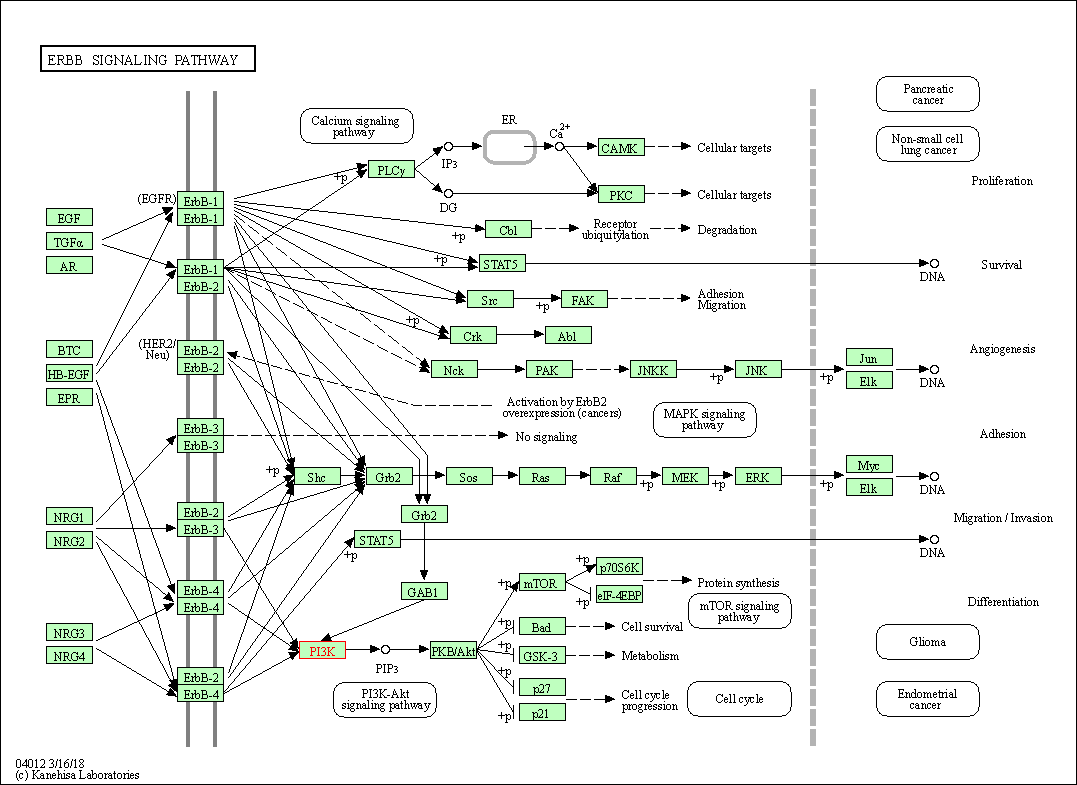
|
| Class: Environmental Information Processing => Signal transduction | Pathway Hierarchy | ||
| Ras signaling pathway | hsa04014 | Affiliated Target |
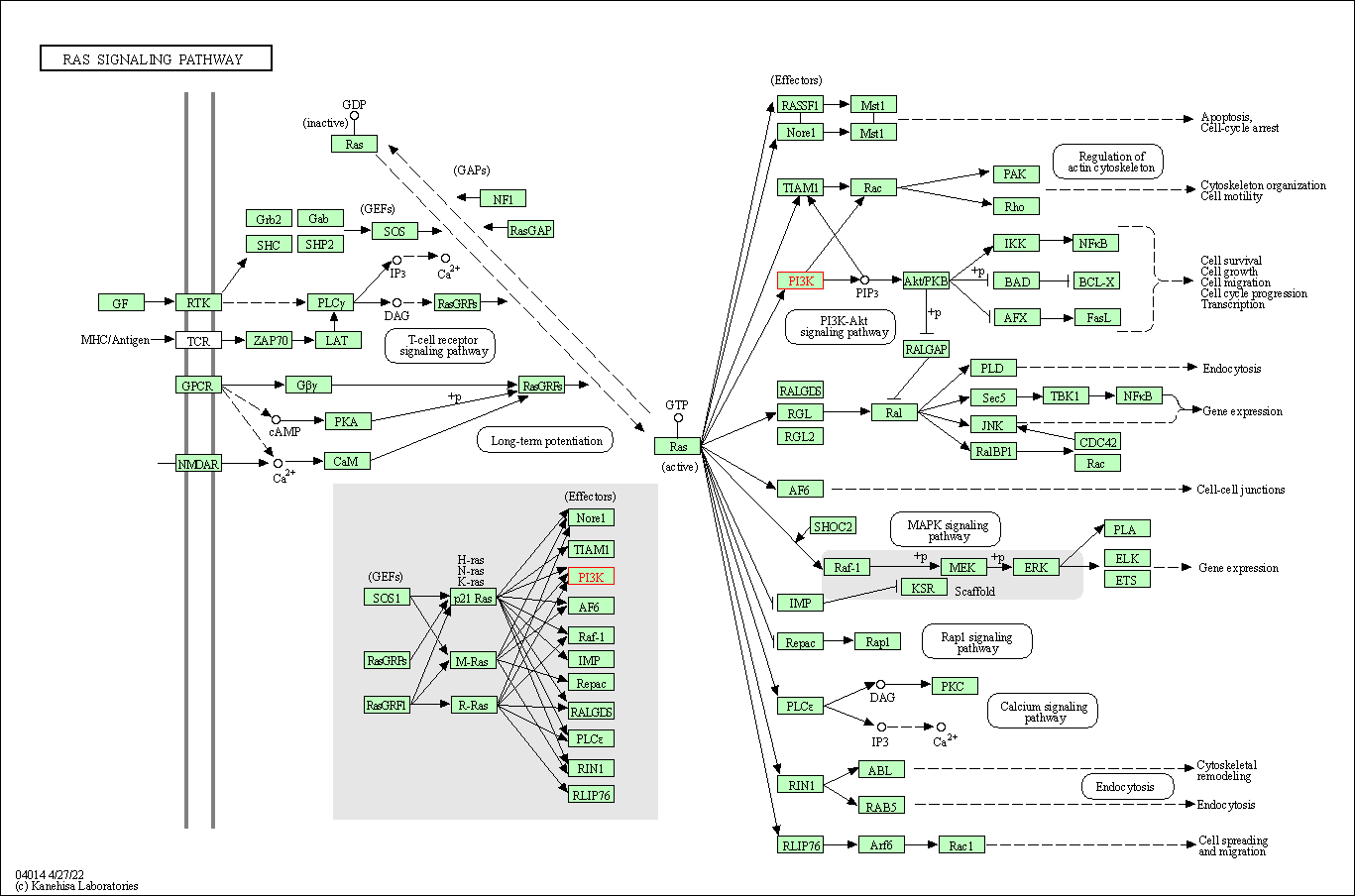
|
| Class: Environmental Information Processing => Signal transduction | Pathway Hierarchy | ||
| Rap1 signaling pathway | hsa04015 | Affiliated Target |
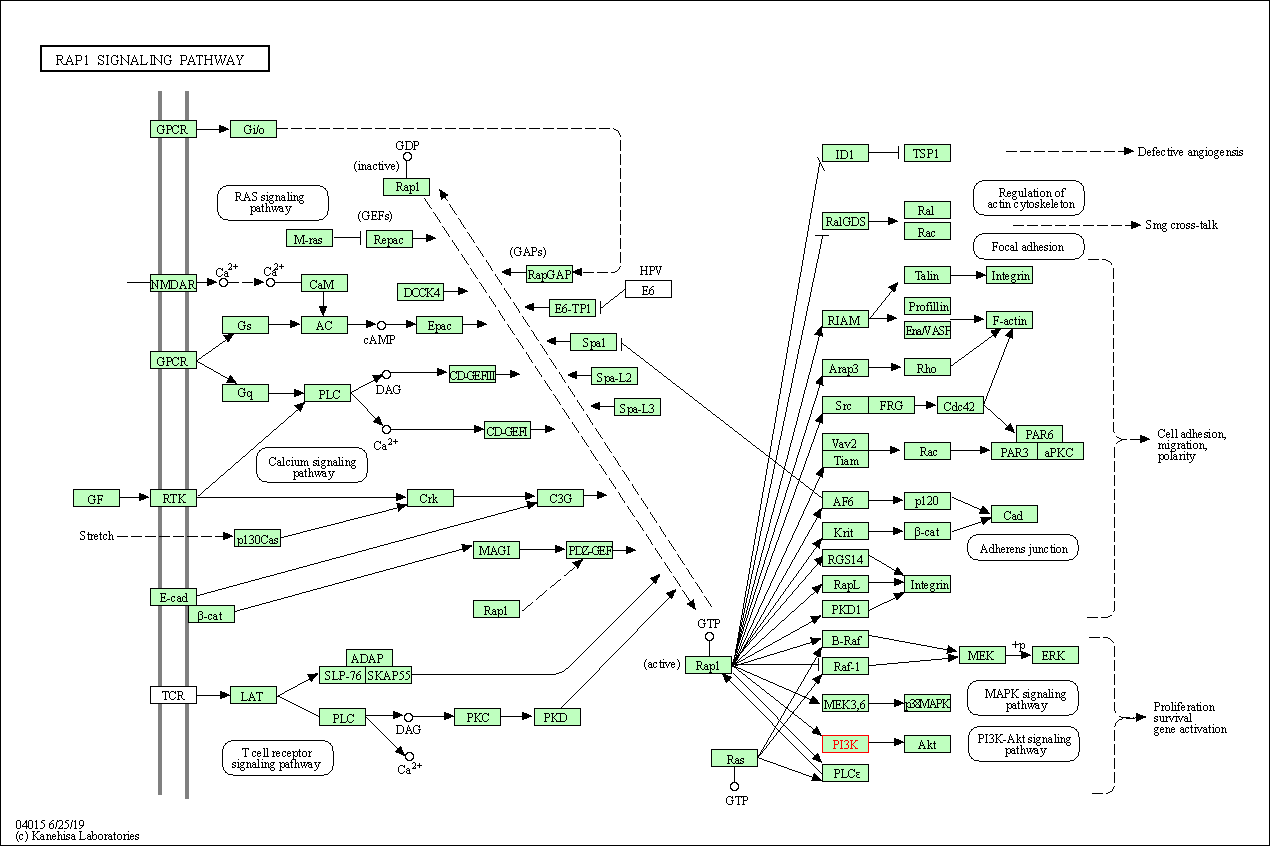
|
| Class: Environmental Information Processing => Signal transduction | Pathway Hierarchy | ||
| cAMP signaling pathway | hsa04024 | Affiliated Target |
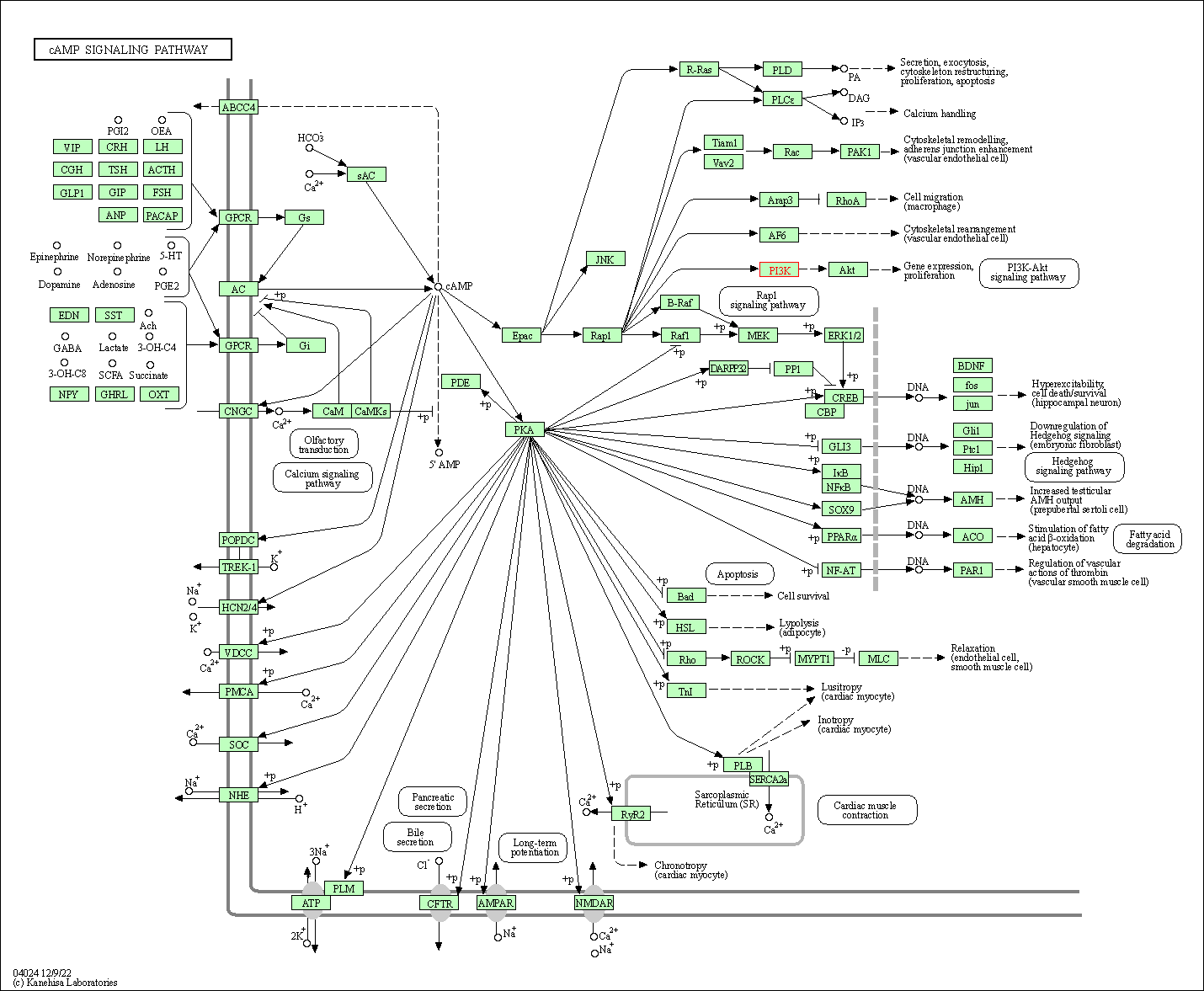
|
| Class: Environmental Information Processing => Signal transduction | Pathway Hierarchy | ||
| Chemokine signaling pathway | hsa04062 | Affiliated Target |
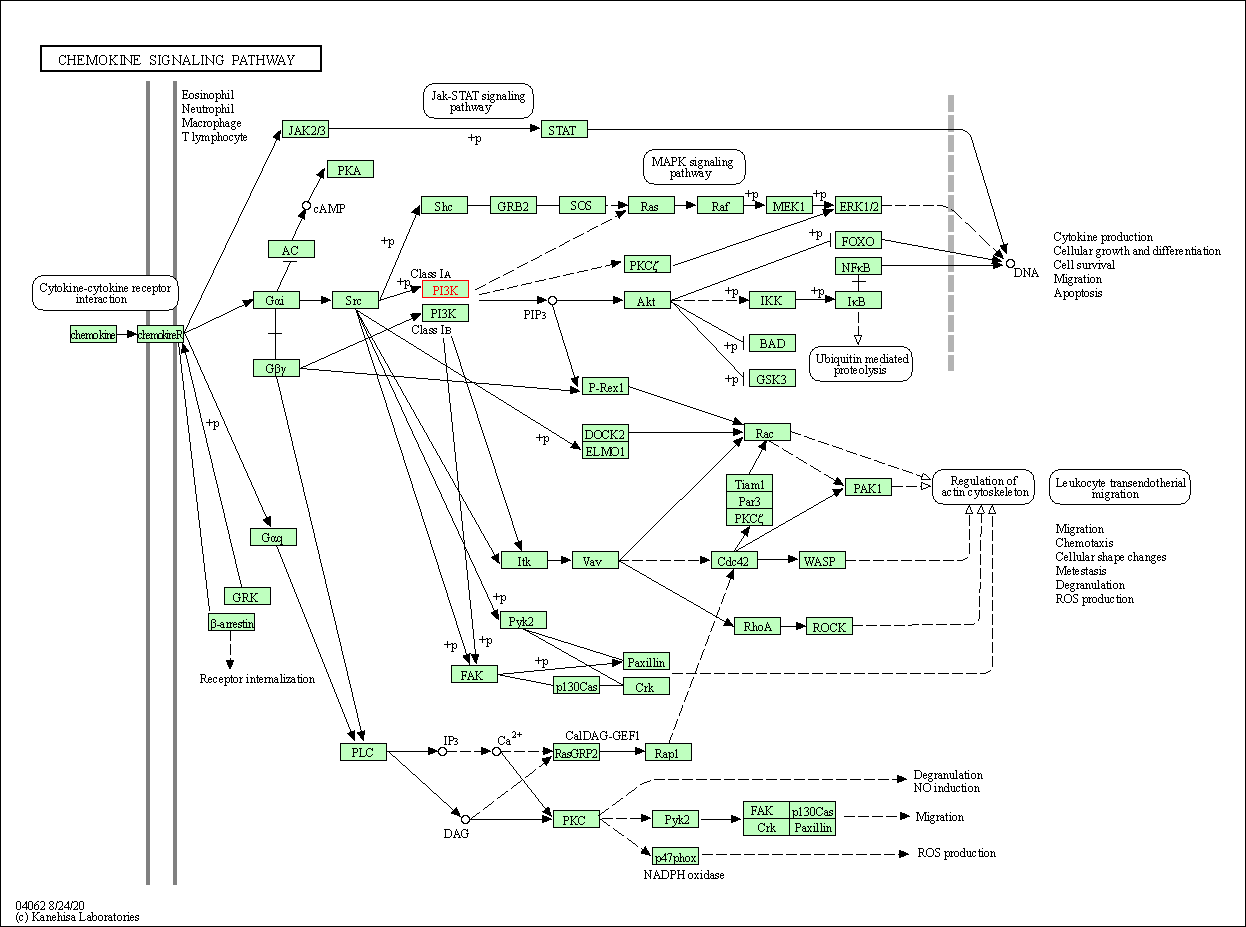
|
| Class: Organismal Systems => Immune system | Pathway Hierarchy | ||
| HIF-1 signaling pathway | hsa04066 | Affiliated Target |
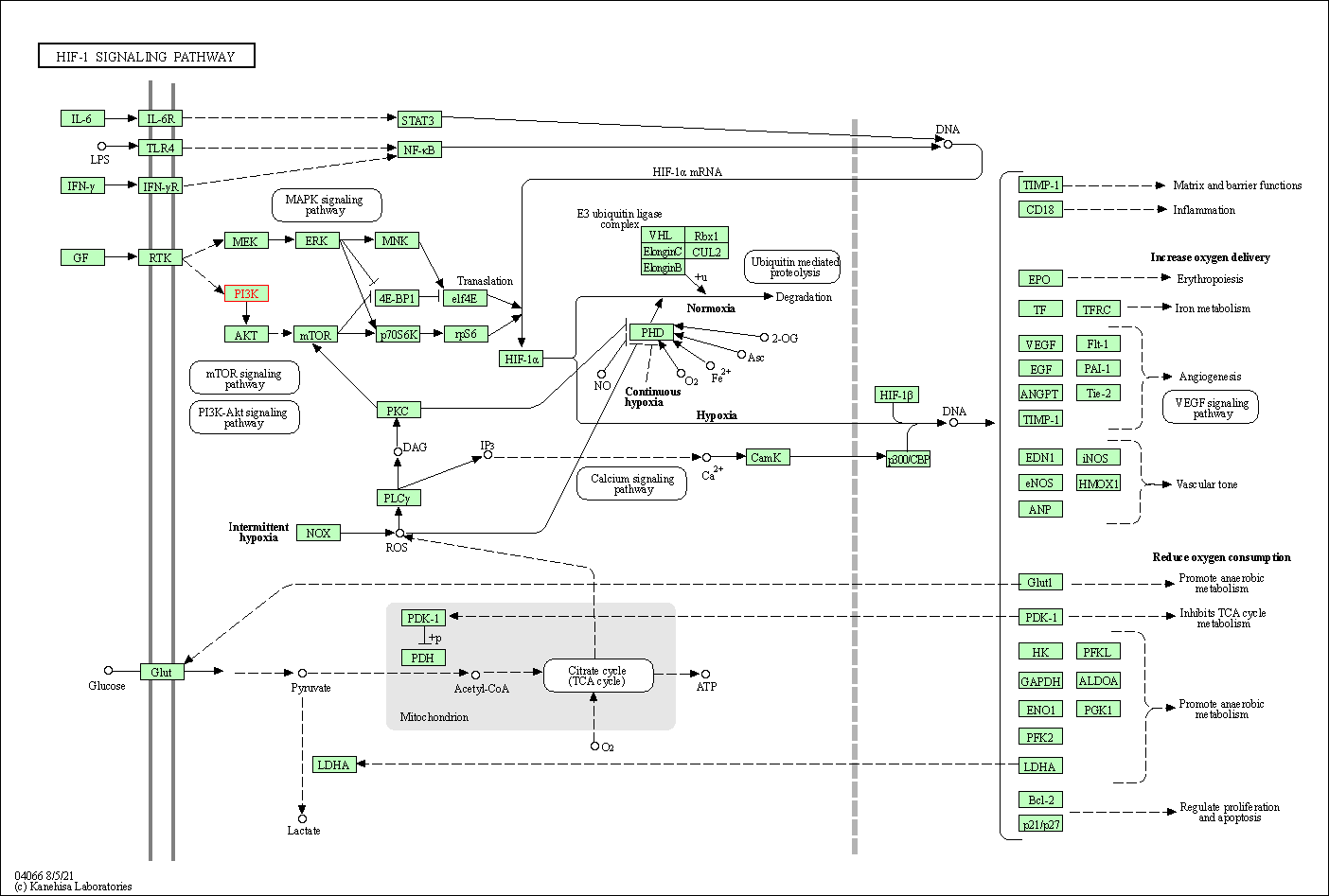
|
| Class: Environmental Information Processing => Signal transduction | Pathway Hierarchy | ||
| FoxO signaling pathway | hsa04068 | Affiliated Target |
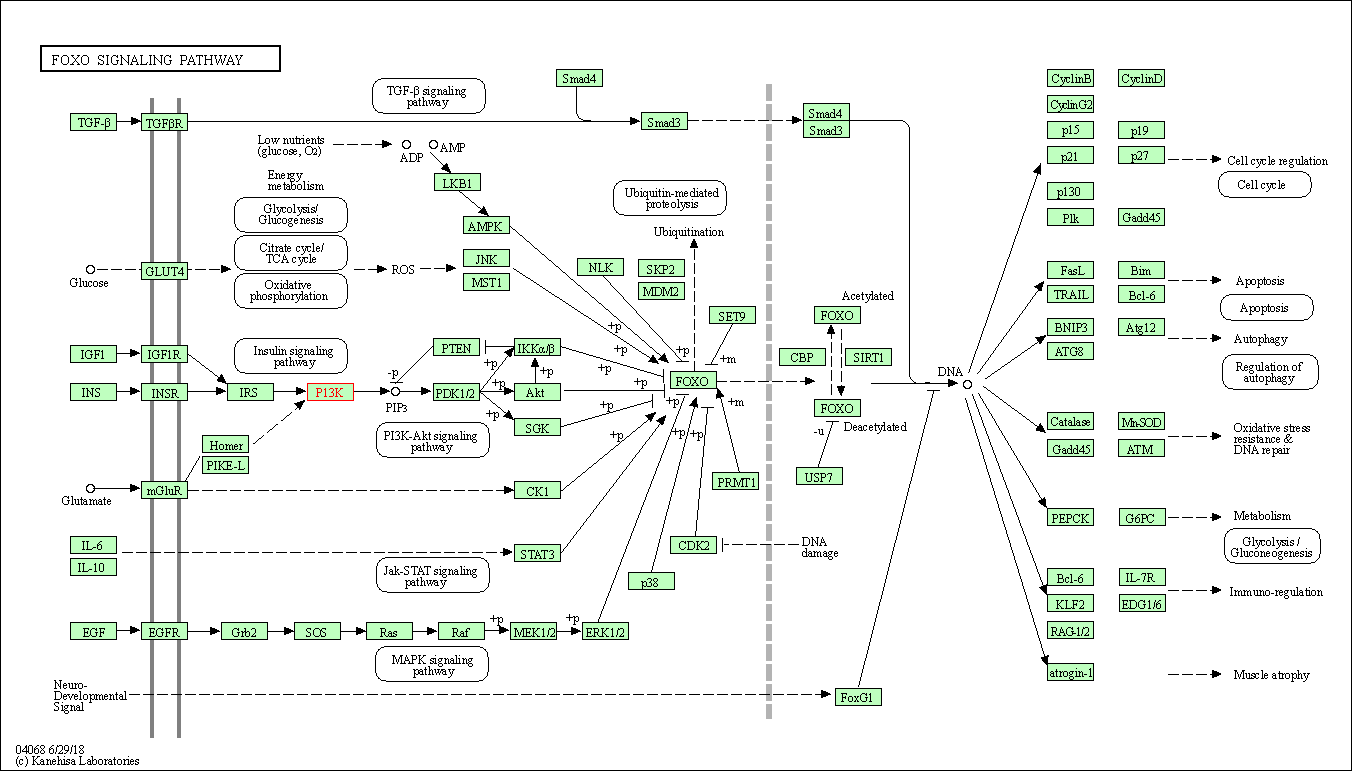
|
| Class: Environmental Information Processing => Signal transduction | Pathway Hierarchy | ||
| Phosphatidylinositol signaling system | hsa04070 | Affiliated Target |
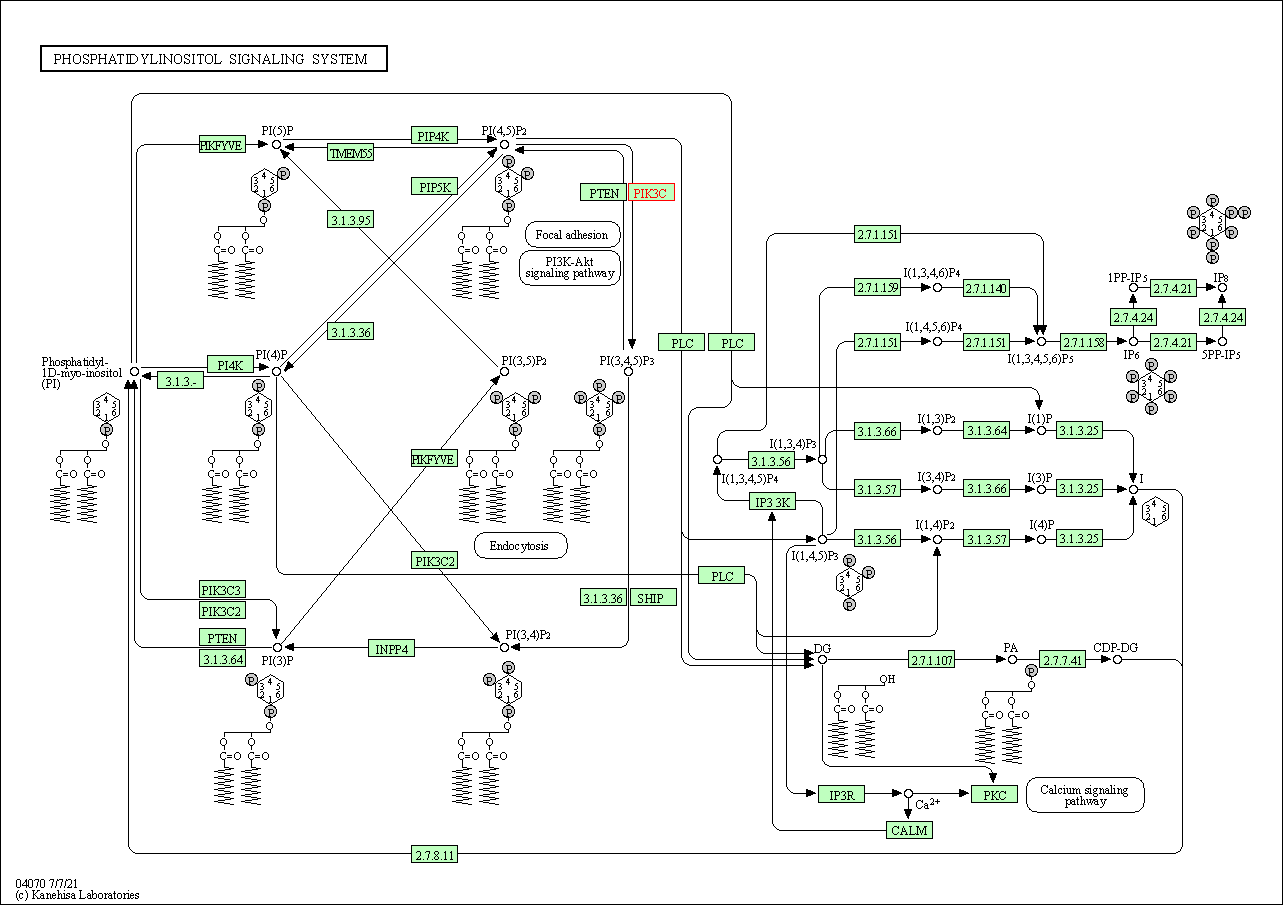
|
| Class: Environmental Information Processing => Signal transduction | Pathway Hierarchy | ||
| Sphingolipid signaling pathway | hsa04071 | Affiliated Target |

|
| Class: Environmental Information Processing => Signal transduction | Pathway Hierarchy | ||
| Phospholipase D signaling pathway | hsa04072 | Affiliated Target |

|
| Class: Environmental Information Processing => Signal transduction | Pathway Hierarchy | ||
| Autophagy - animal | hsa04140 | Affiliated Target |
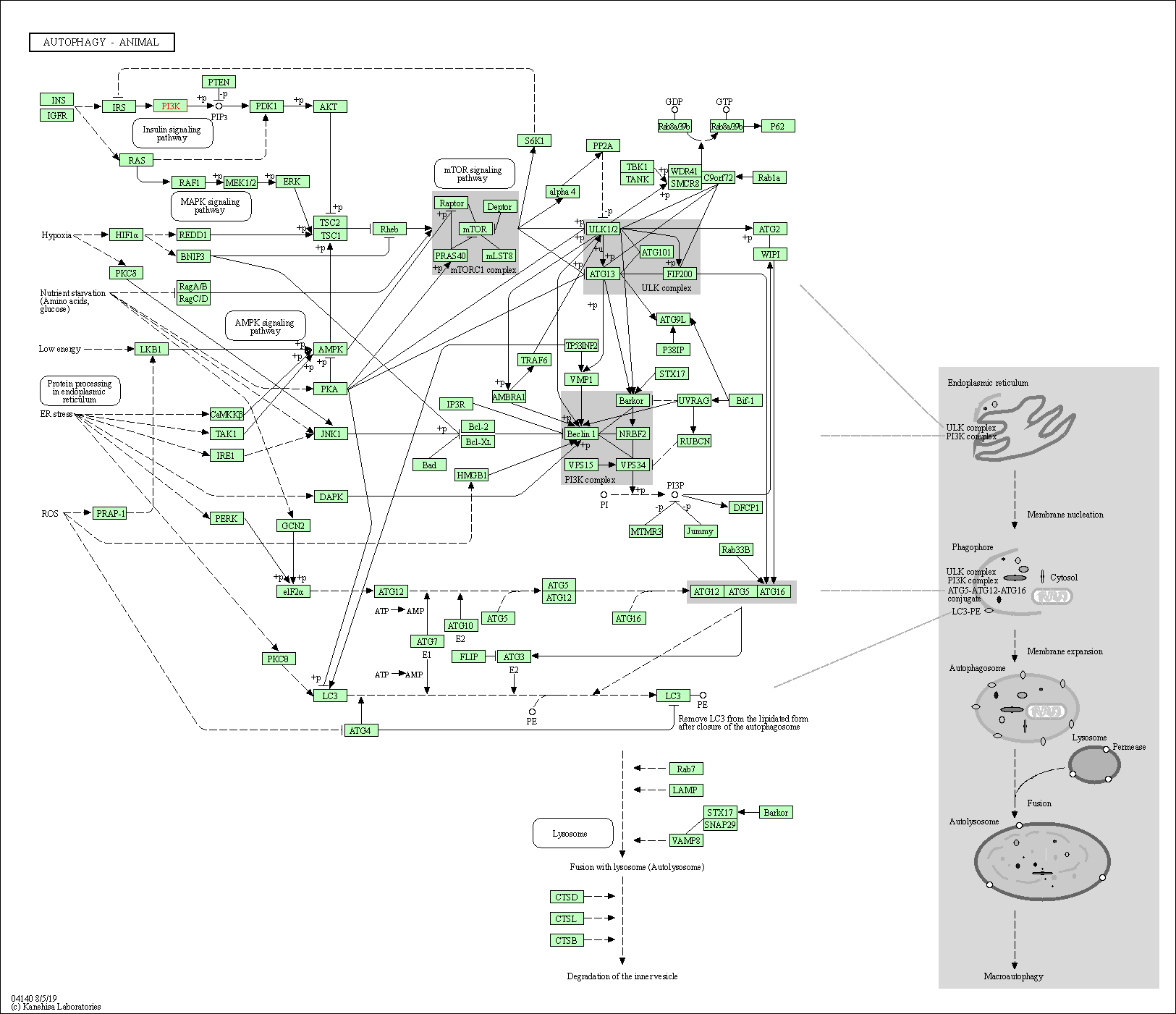
|
| Class: Cellular Processes => Transport and catabolism | Pathway Hierarchy | ||
| mTOR signaling pathway | hsa04150 | Affiliated Target |
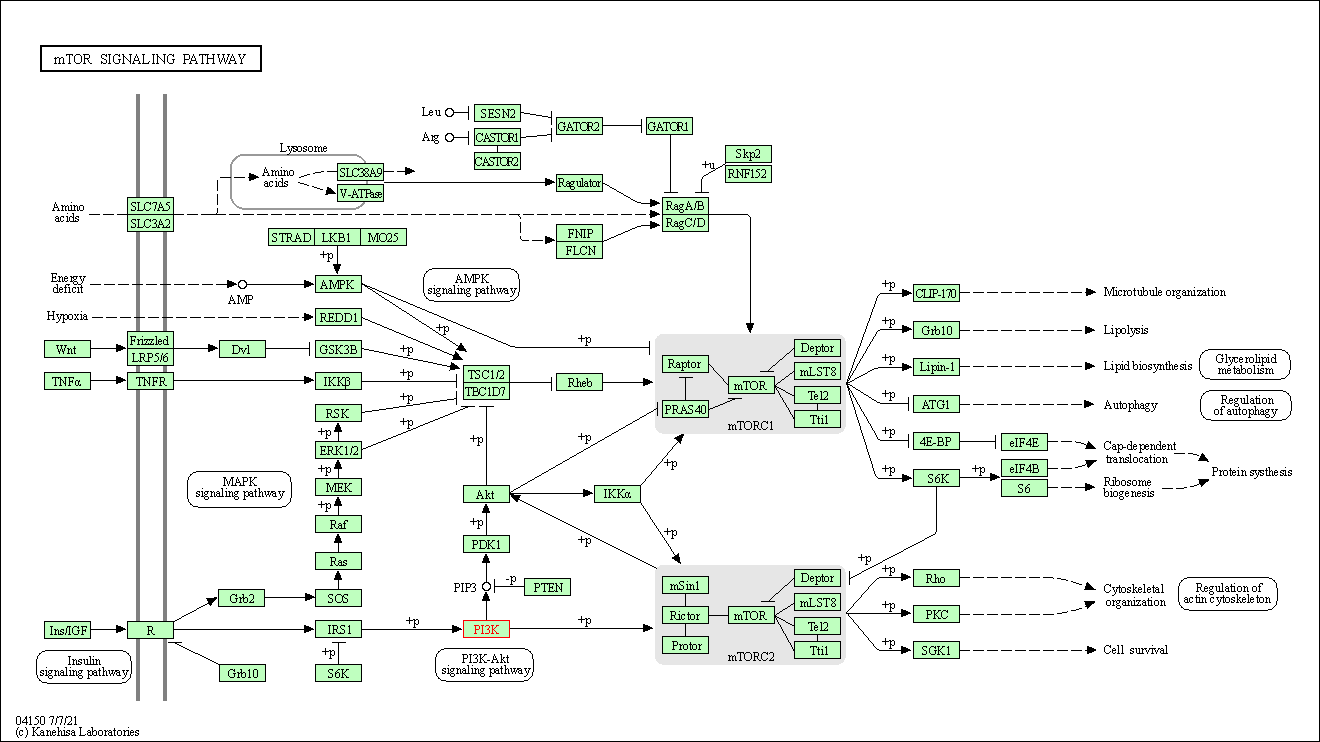
|
| Class: Environmental Information Processing => Signal transduction | Pathway Hierarchy | ||
| PI3K-Akt signaling pathway | hsa04151 | Affiliated Target |

|
| Class: Environmental Information Processing => Signal transduction | Pathway Hierarchy | ||
| AMPK signaling pathway | hsa04152 | Affiliated Target |
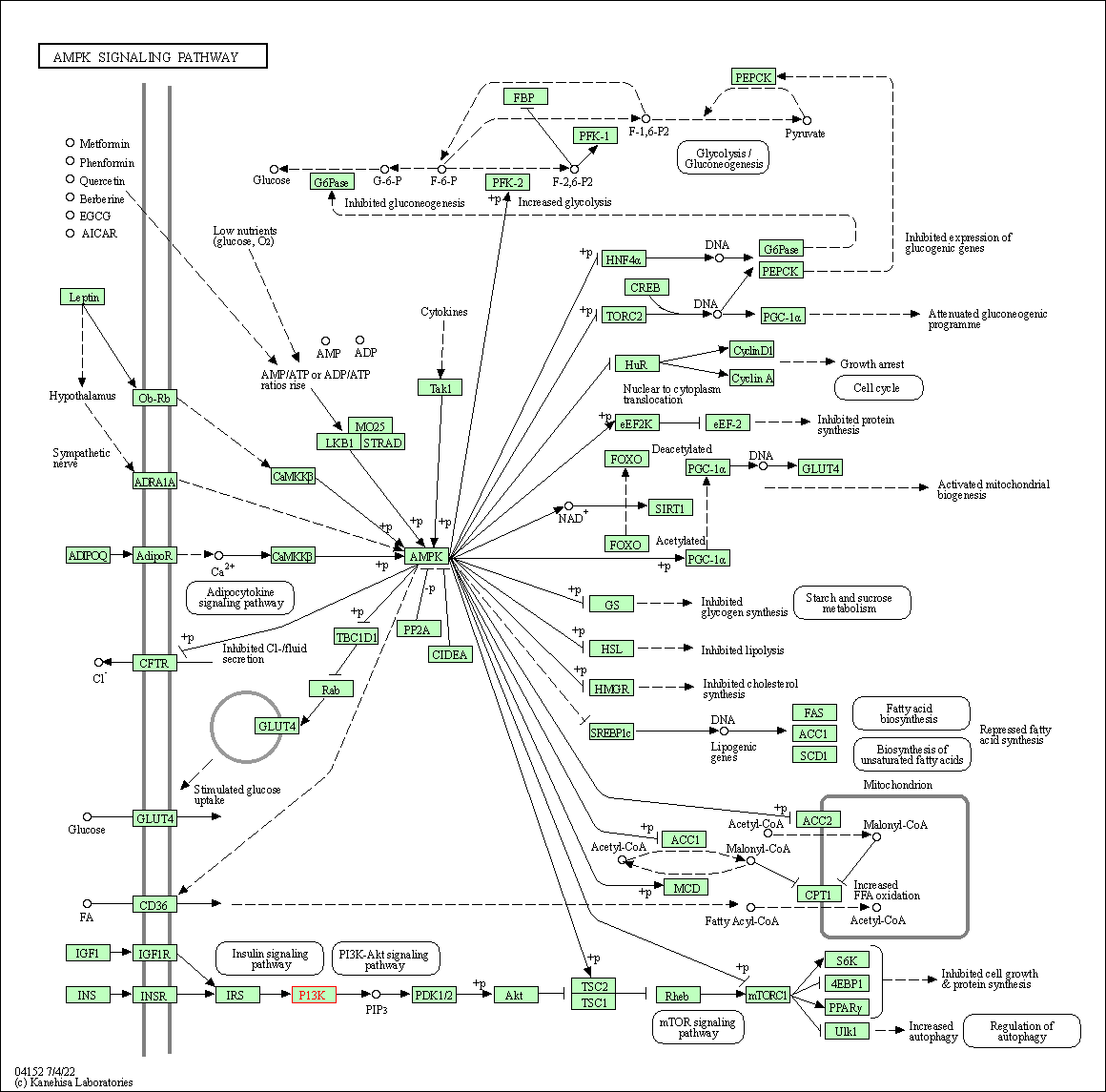
|
| Class: Environmental Information Processing => Signal transduction | Pathway Hierarchy | ||
| Apoptosis | hsa04210 | Affiliated Target |
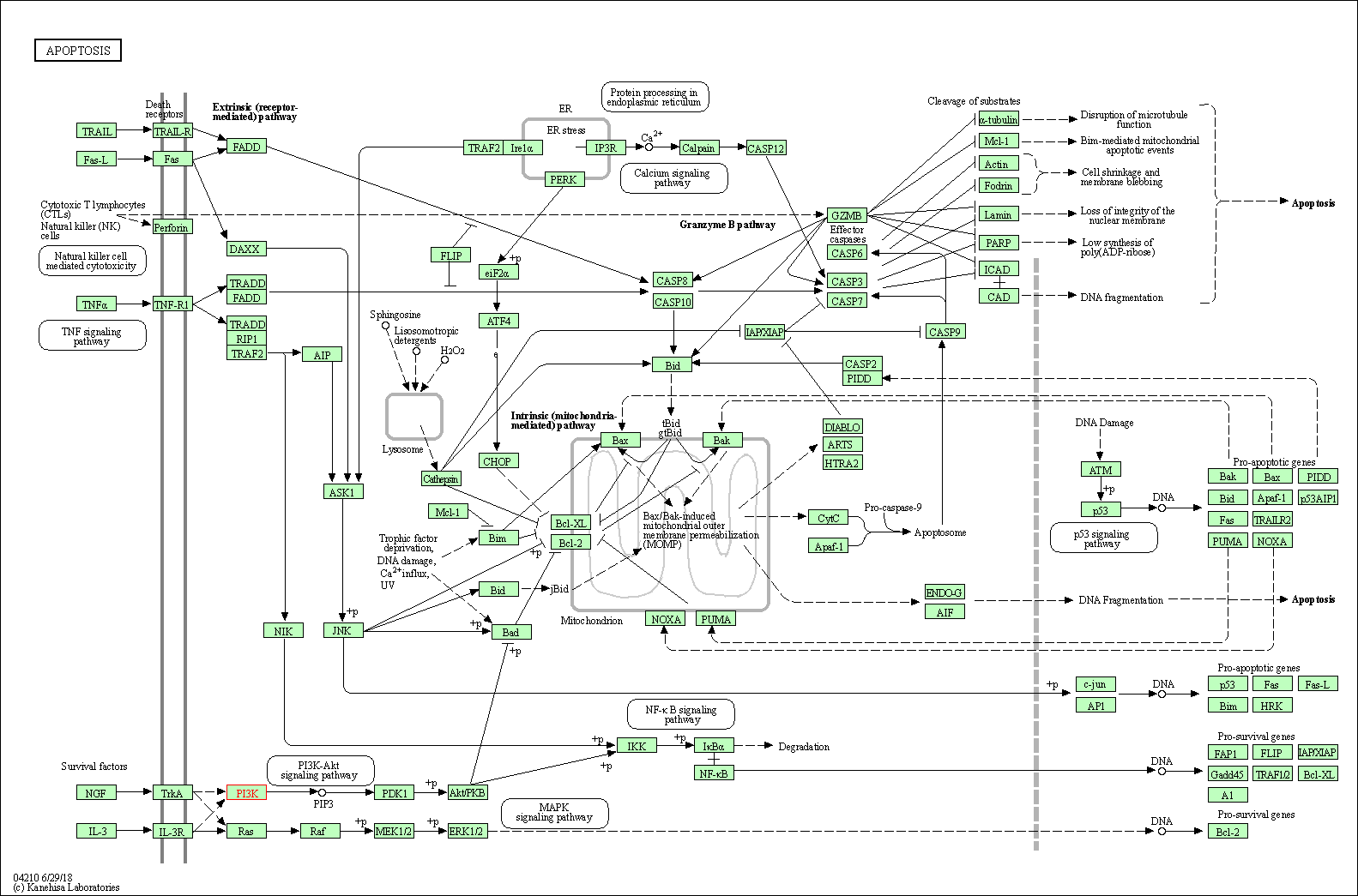
|
| Class: Cellular Processes => Cell growth and death | Pathway Hierarchy | ||
| Longevity regulating pathway | hsa04211 | Affiliated Target |
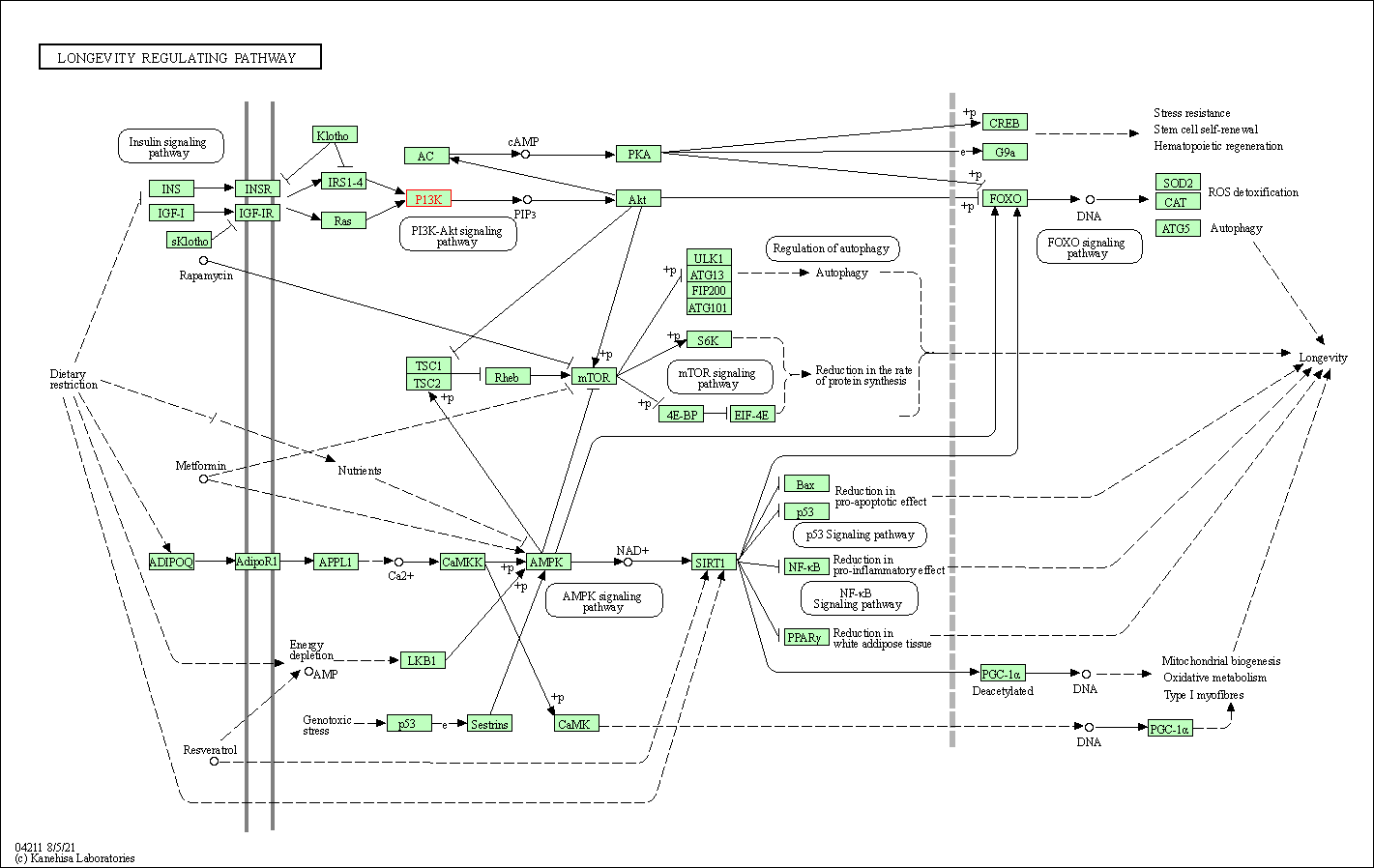
|
| Class: Organismal Systems => Aging | Pathway Hierarchy | ||
| Longevity regulating pathway - multiple species | hsa04213 | Affiliated Target |
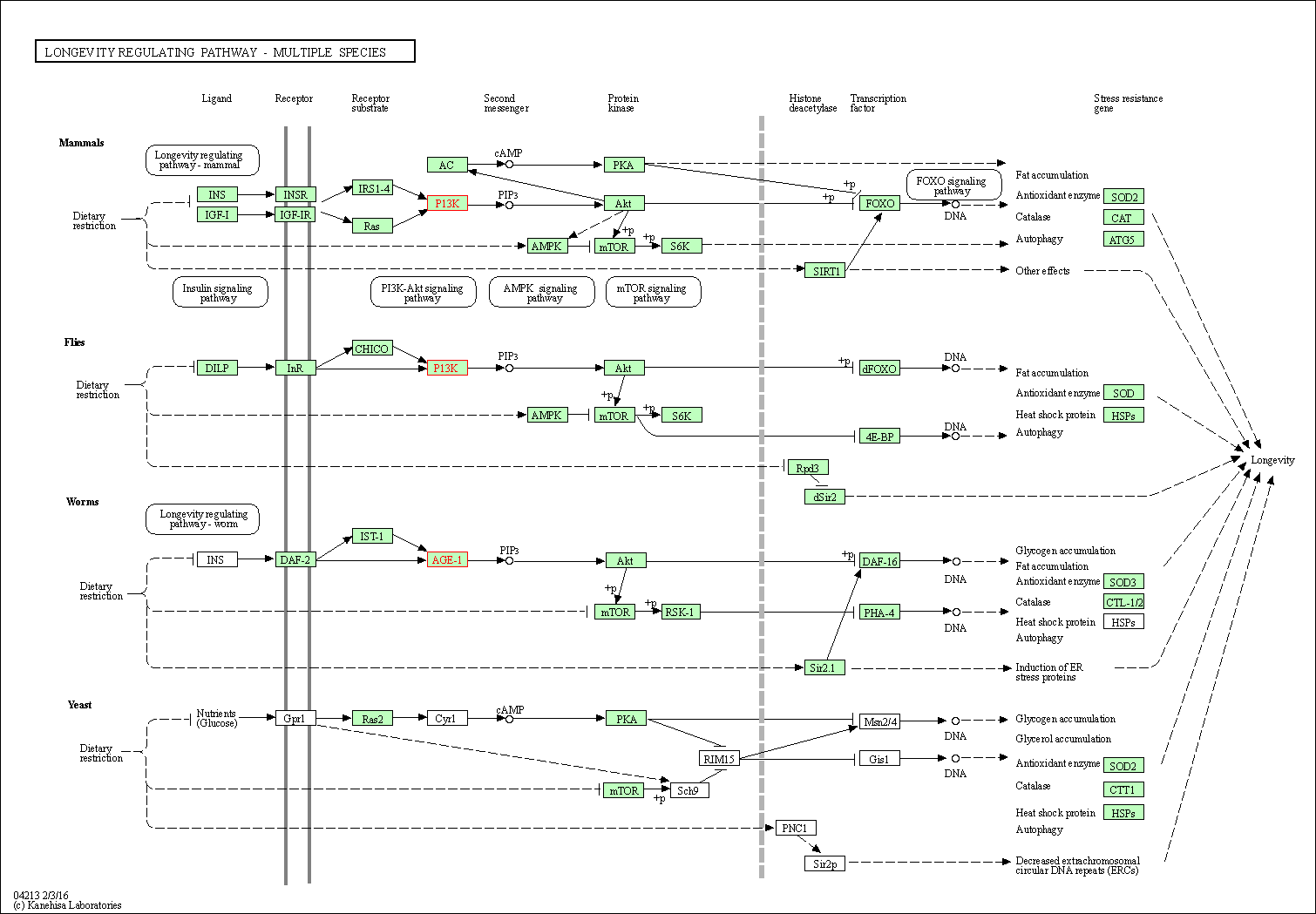
|
| Class: Organismal Systems => Aging | Pathway Hierarchy | ||
| Cellular senescence | hsa04218 | Affiliated Target |
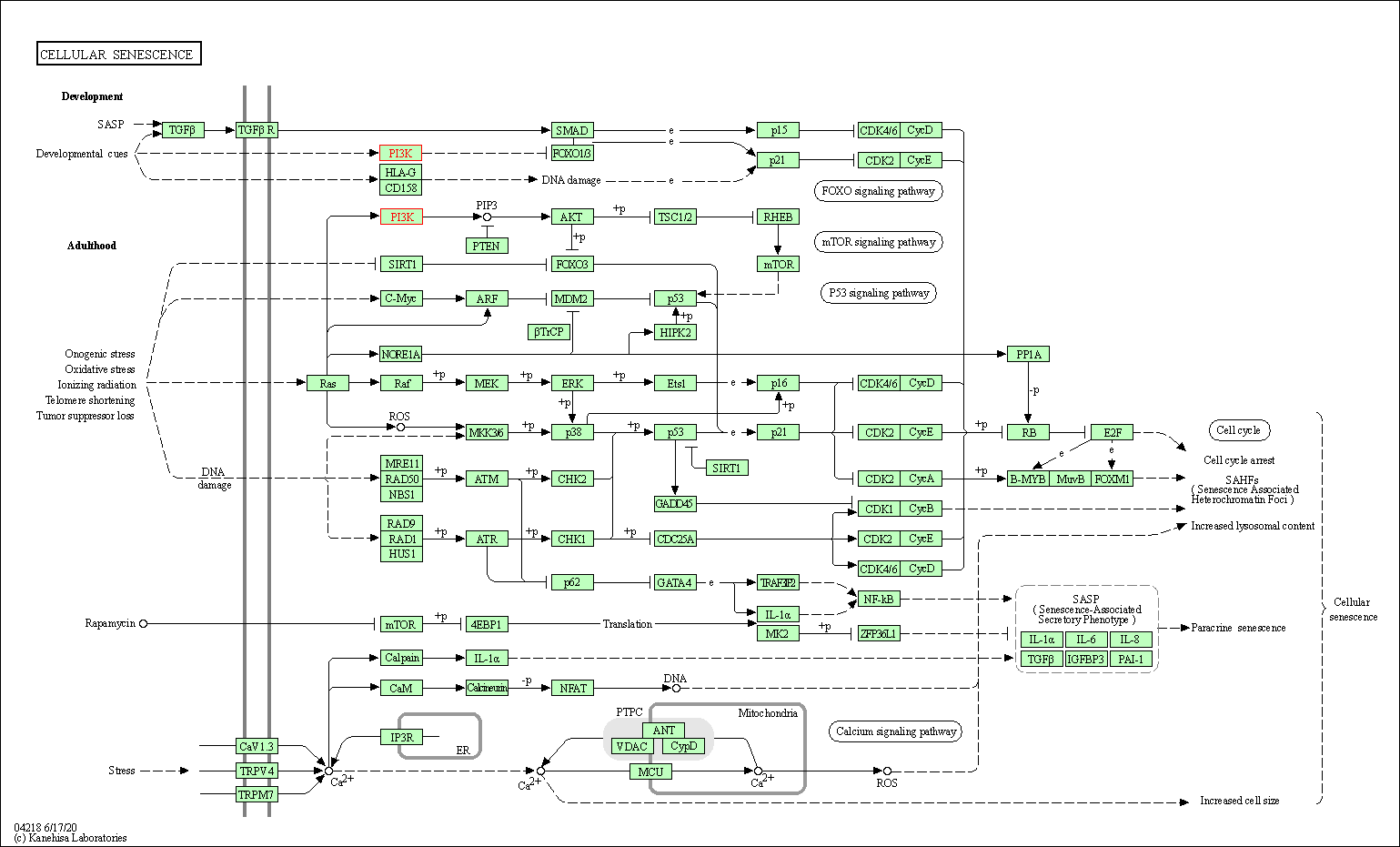
|
| Class: Cellular Processes => Cell growth and death | Pathway Hierarchy | ||
| Axon guidance | hsa04360 | Affiliated Target |
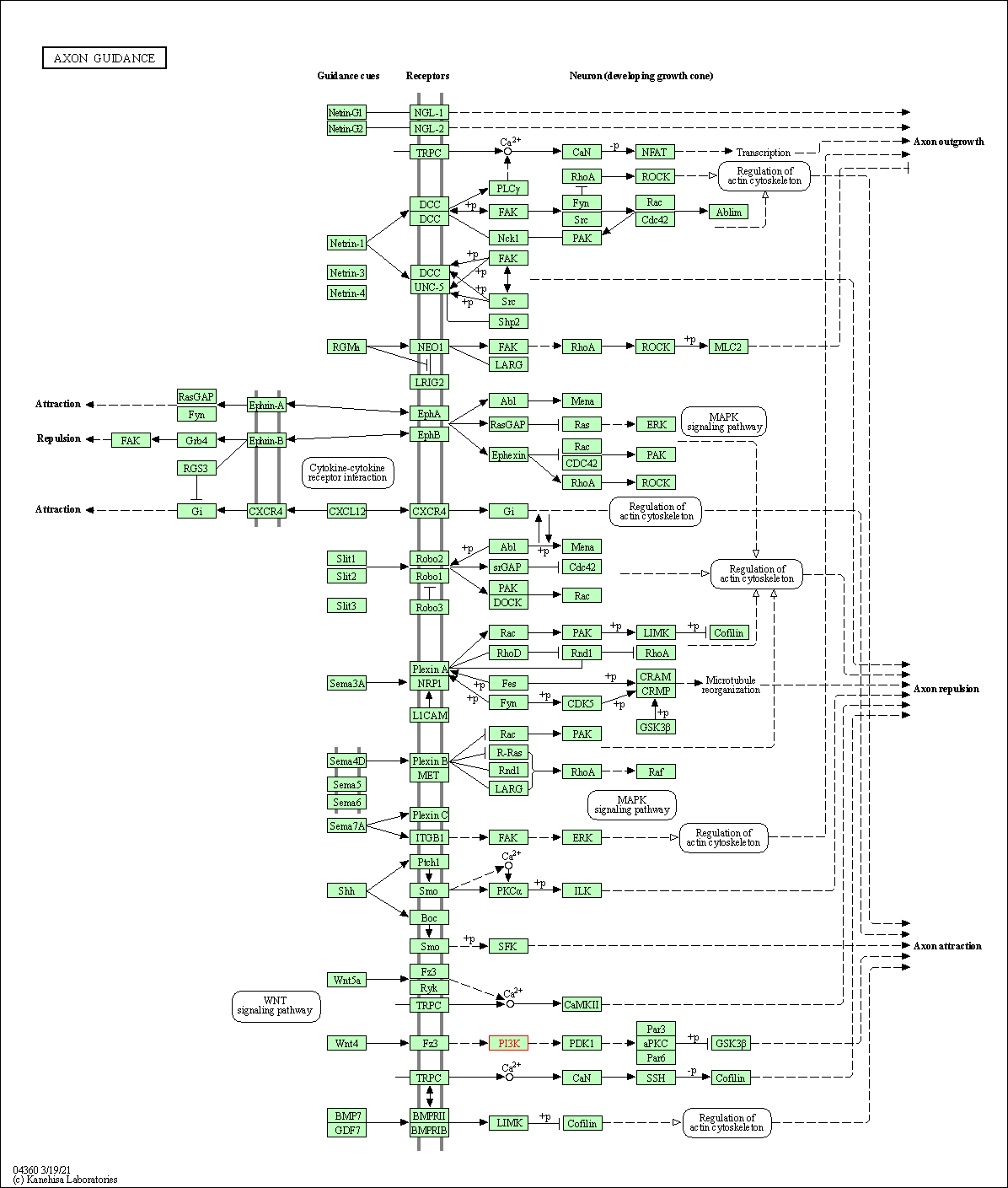
|
| Class: Organismal Systems => Development and regeneration | Pathway Hierarchy | ||
| VEGF signaling pathway | hsa04370 | Affiliated Target |
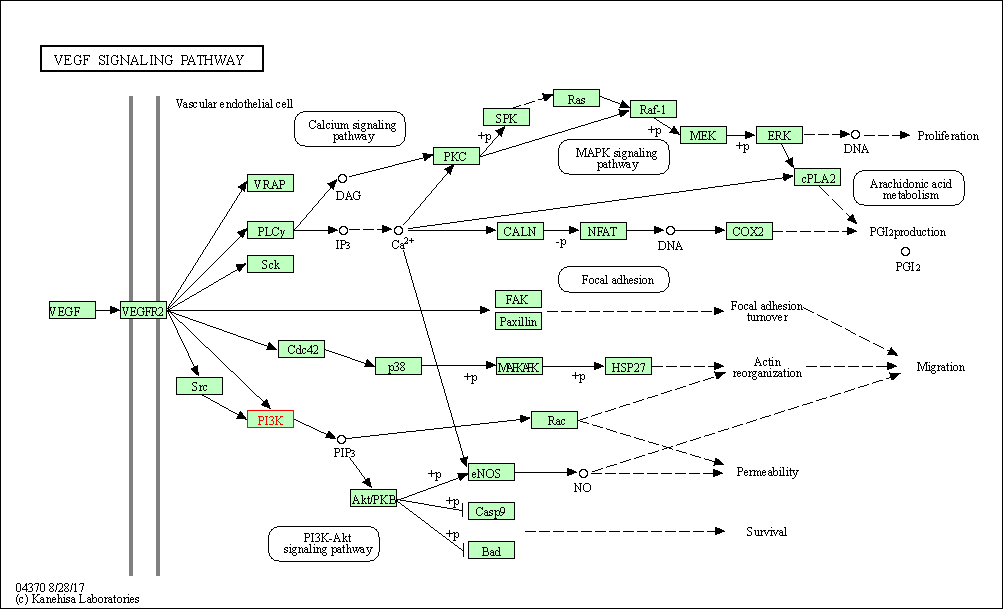
|
| Class: Environmental Information Processing => Signal transduction | Pathway Hierarchy | ||
| Osteoclast differentiation | hsa04380 | Affiliated Target |
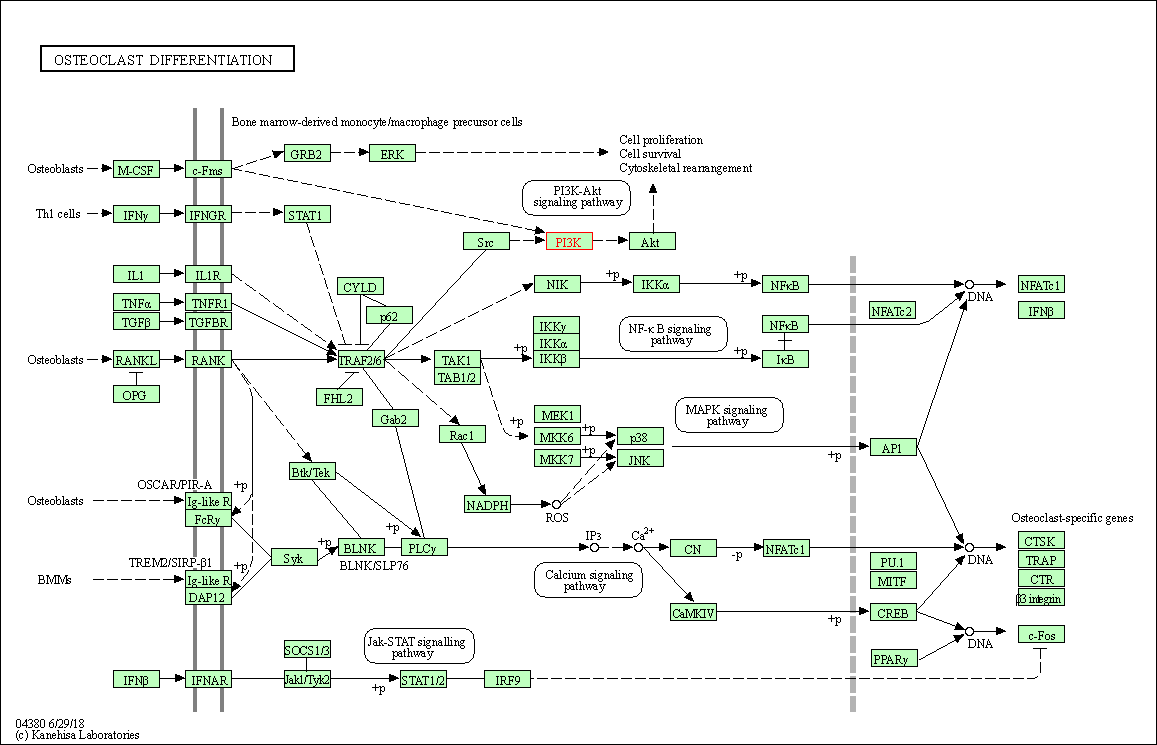
|
| Class: Organismal Systems => Development and regeneration | Pathway Hierarchy | ||
| Focal adhesion | hsa04510 | Affiliated Target |

|
| Class: Cellular Processes => Cellular community - eukaryotes | Pathway Hierarchy | ||
| Signaling pathways regulating pluripotency of stem cells | hsa04550 | Affiliated Target |
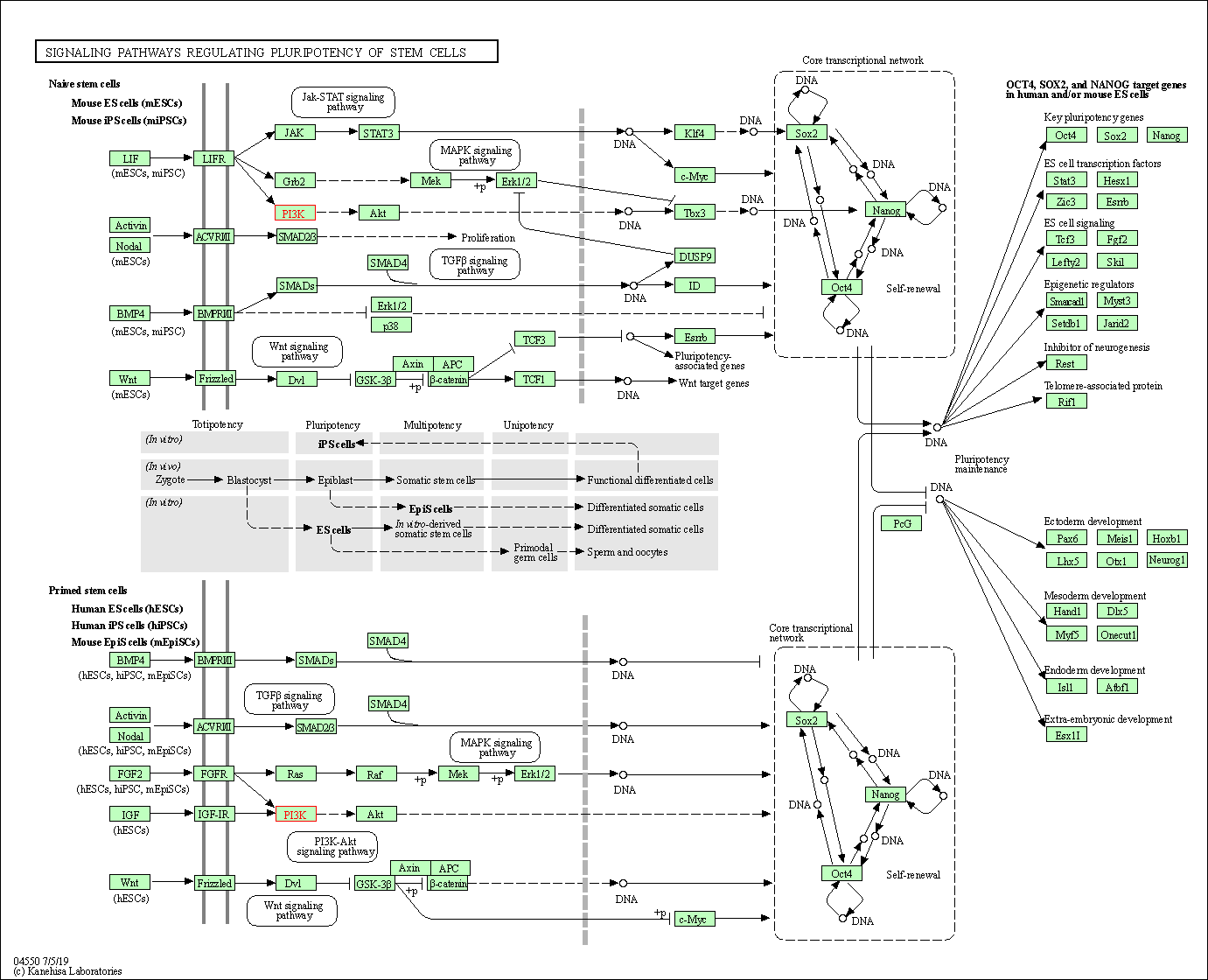
|
| Class: Cellular Processes => Cellular community - eukaryotes | Pathway Hierarchy | ||
| Platelet activation | hsa04611 | Affiliated Target |
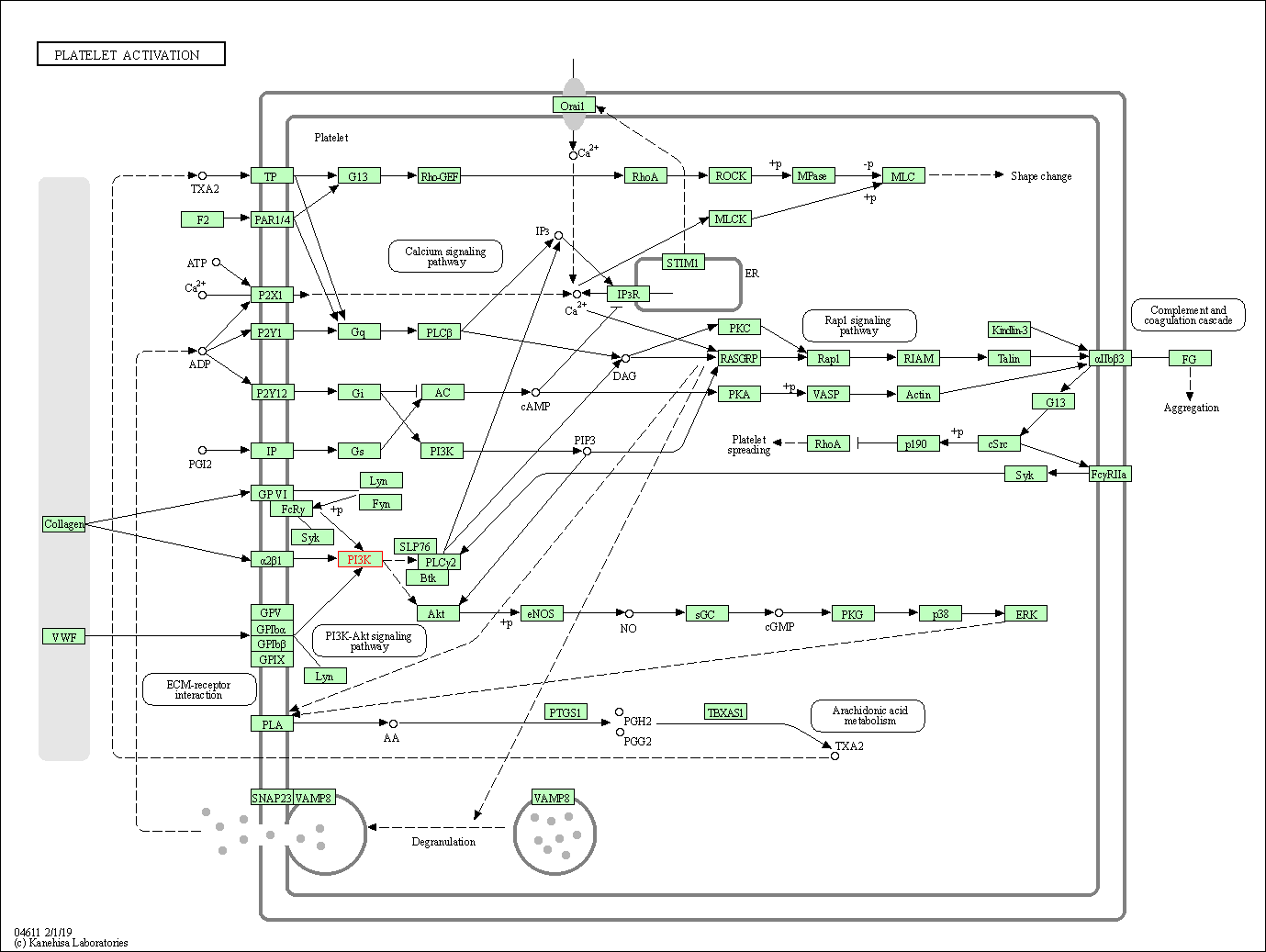
|
| Class: Organismal Systems => Immune system | Pathway Hierarchy | ||
| Neutrophil extracellular trap formation | hsa04613 | Affiliated Target |
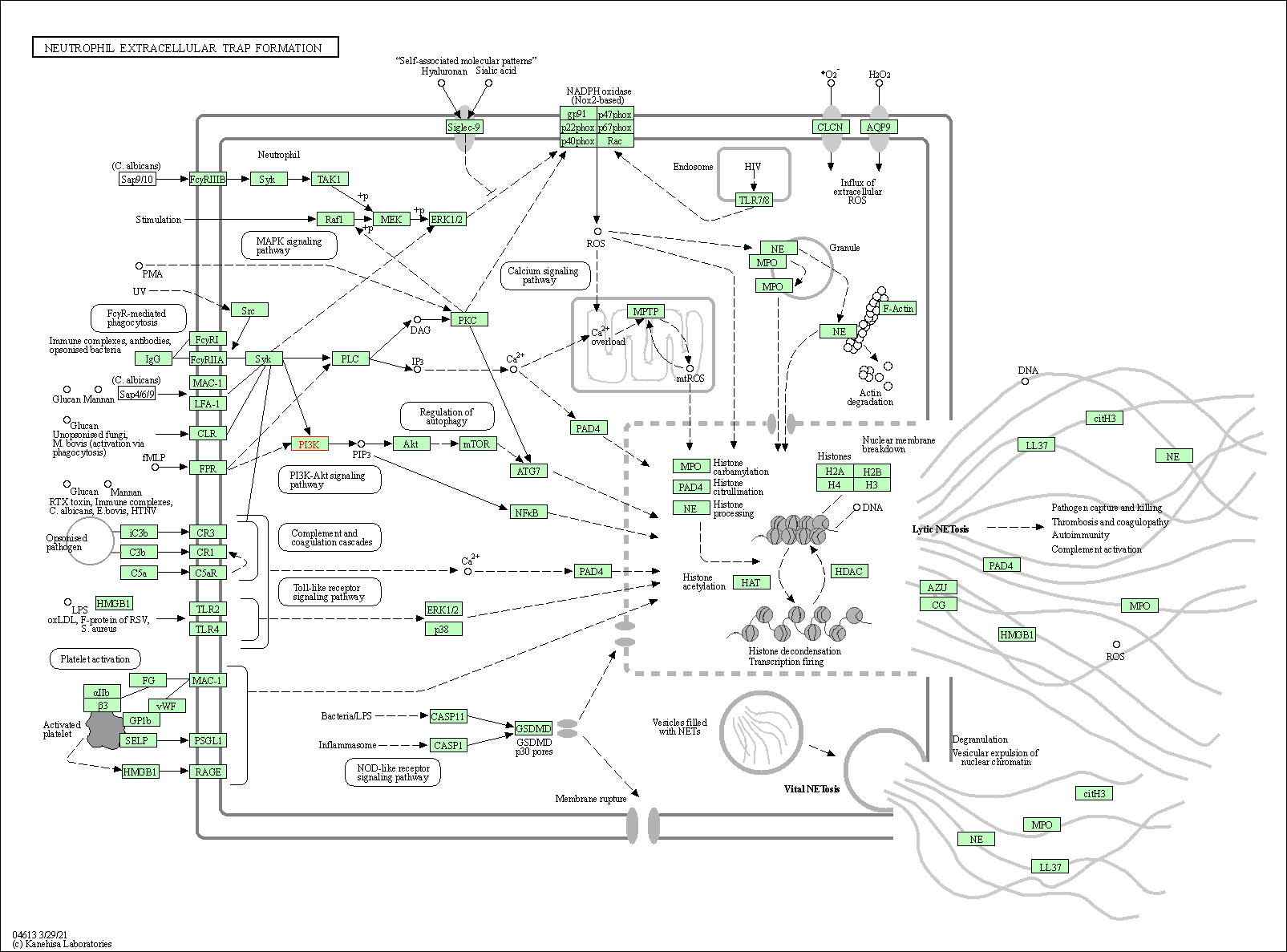
|
| Class: Organismal Systems => Immune system | Pathway Hierarchy | ||
| Toll-like receptor signaling pathway | hsa04620 | Affiliated Target |

|
| Class: Organismal Systems => Immune system | Pathway Hierarchy | ||
| C-type lectin receptor signaling pathway | hsa04625 | Affiliated Target |

|
| Class: Organismal Systems => Immune system | Pathway Hierarchy | ||
| JAK-STAT signaling pathway | hsa04630 | Affiliated Target |
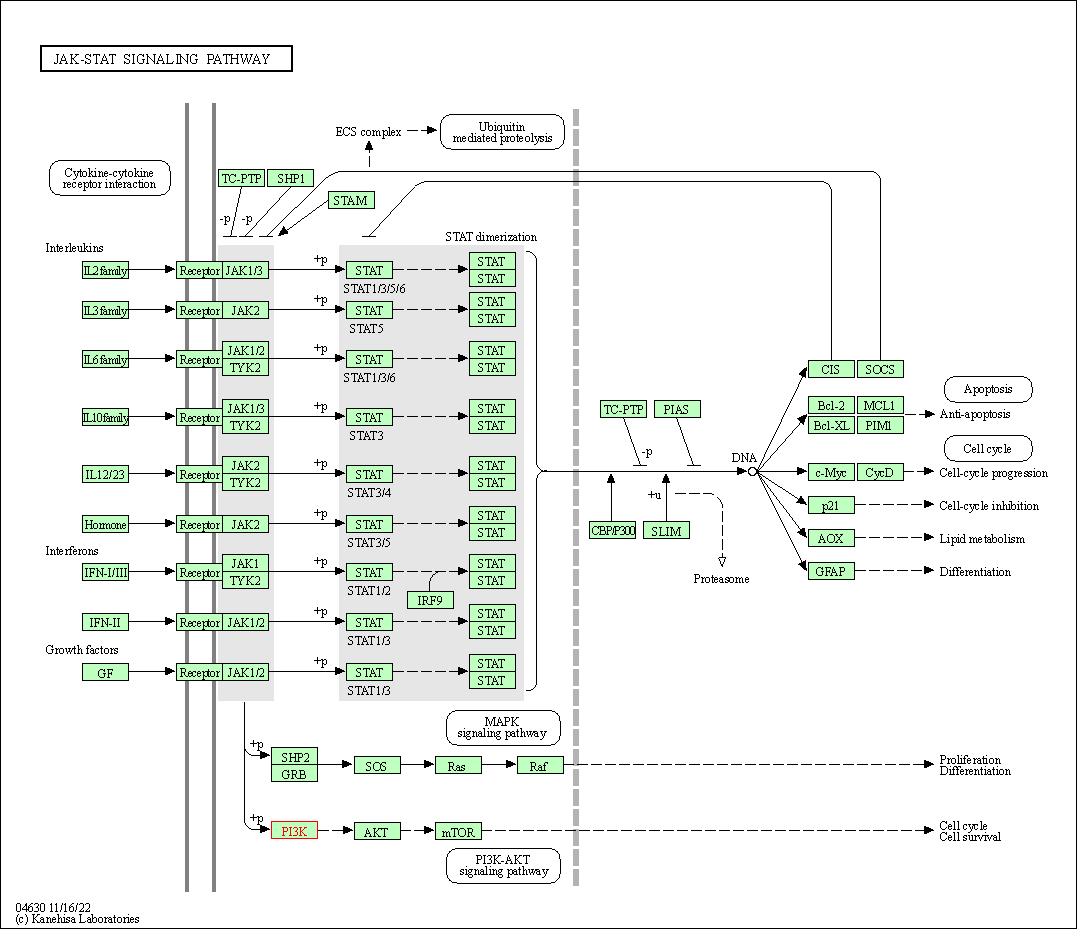
|
| Class: Environmental Information Processing => Signal transduction | Pathway Hierarchy | ||
| Natural killer cell mediated cytotoxicity | hsa04650 | Affiliated Target |
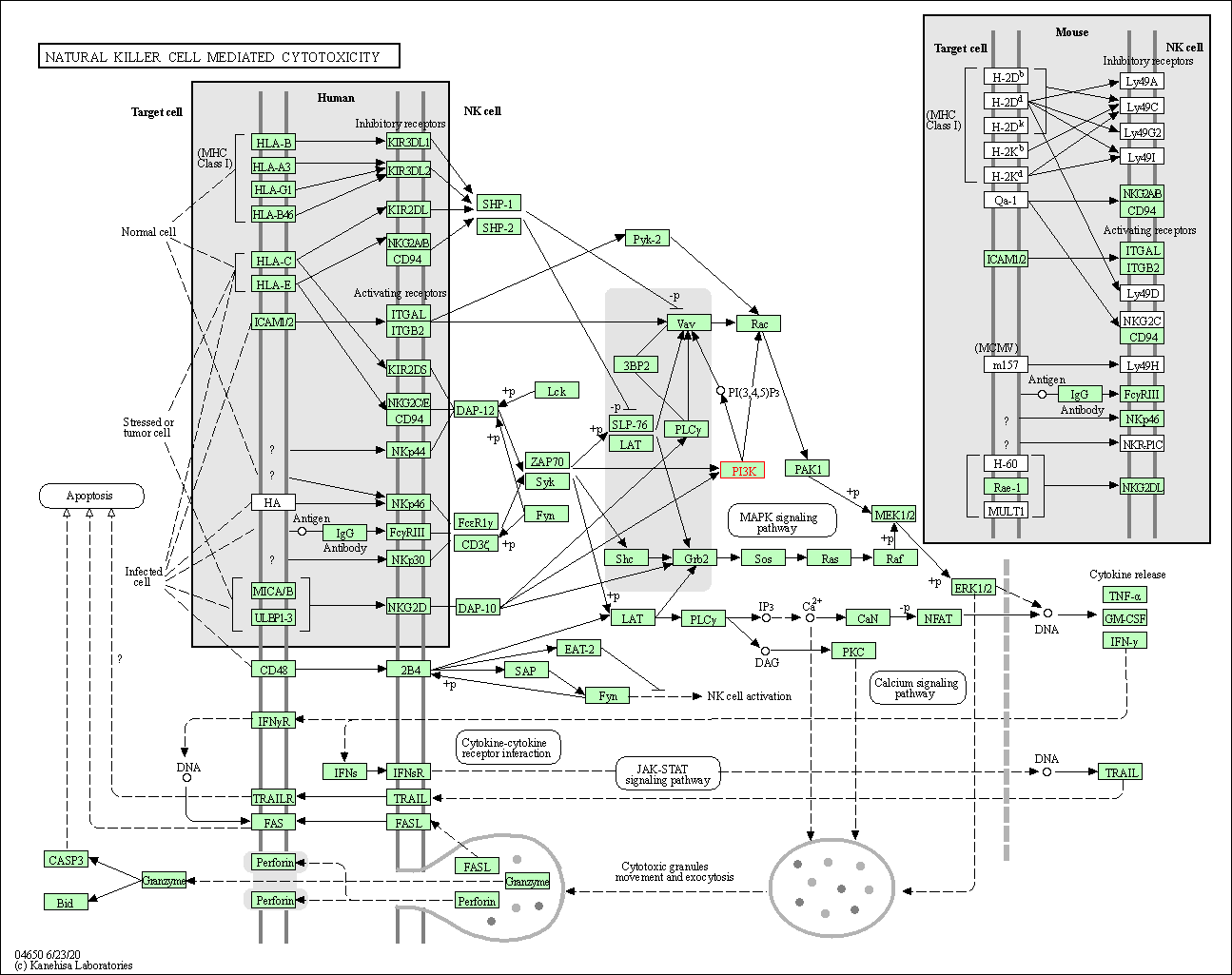
|
| Class: Organismal Systems => Immune system | Pathway Hierarchy | ||
| T cell receptor signaling pathway | hsa04660 | Affiliated Target |

|
| Class: Organismal Systems => Immune system | Pathway Hierarchy | ||
| B cell receptor signaling pathway | hsa04662 | Affiliated Target |
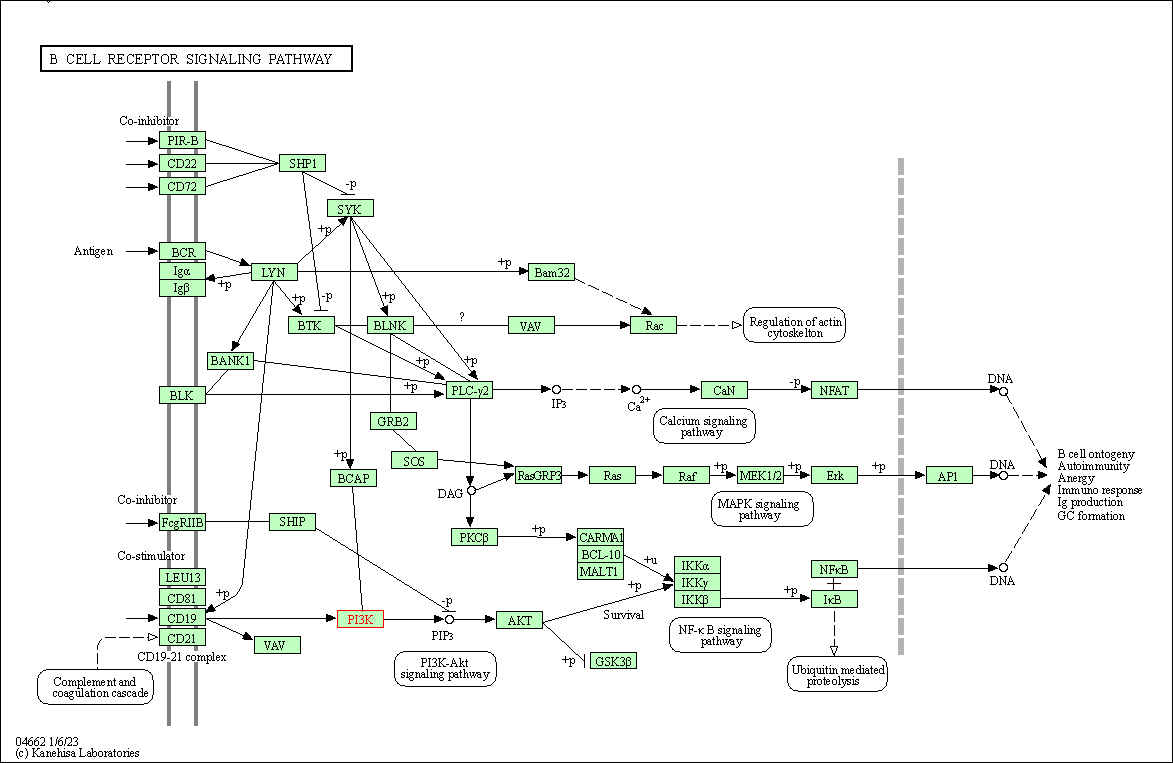
|
| Class: Organismal Systems => Immune system | Pathway Hierarchy | ||
| Fc epsilon RI signaling pathway | hsa04664 | Affiliated Target |
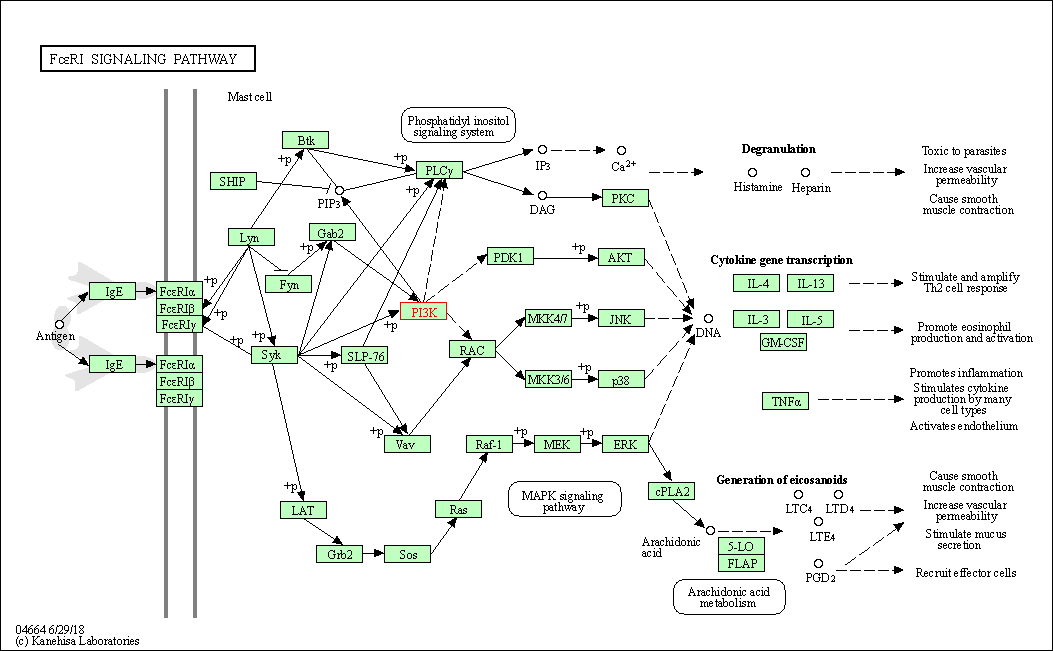
|
| Class: Organismal Systems => Immune system | Pathway Hierarchy | ||
| Fc gamma R-mediated phagocytosis | hsa04666 | Affiliated Target |
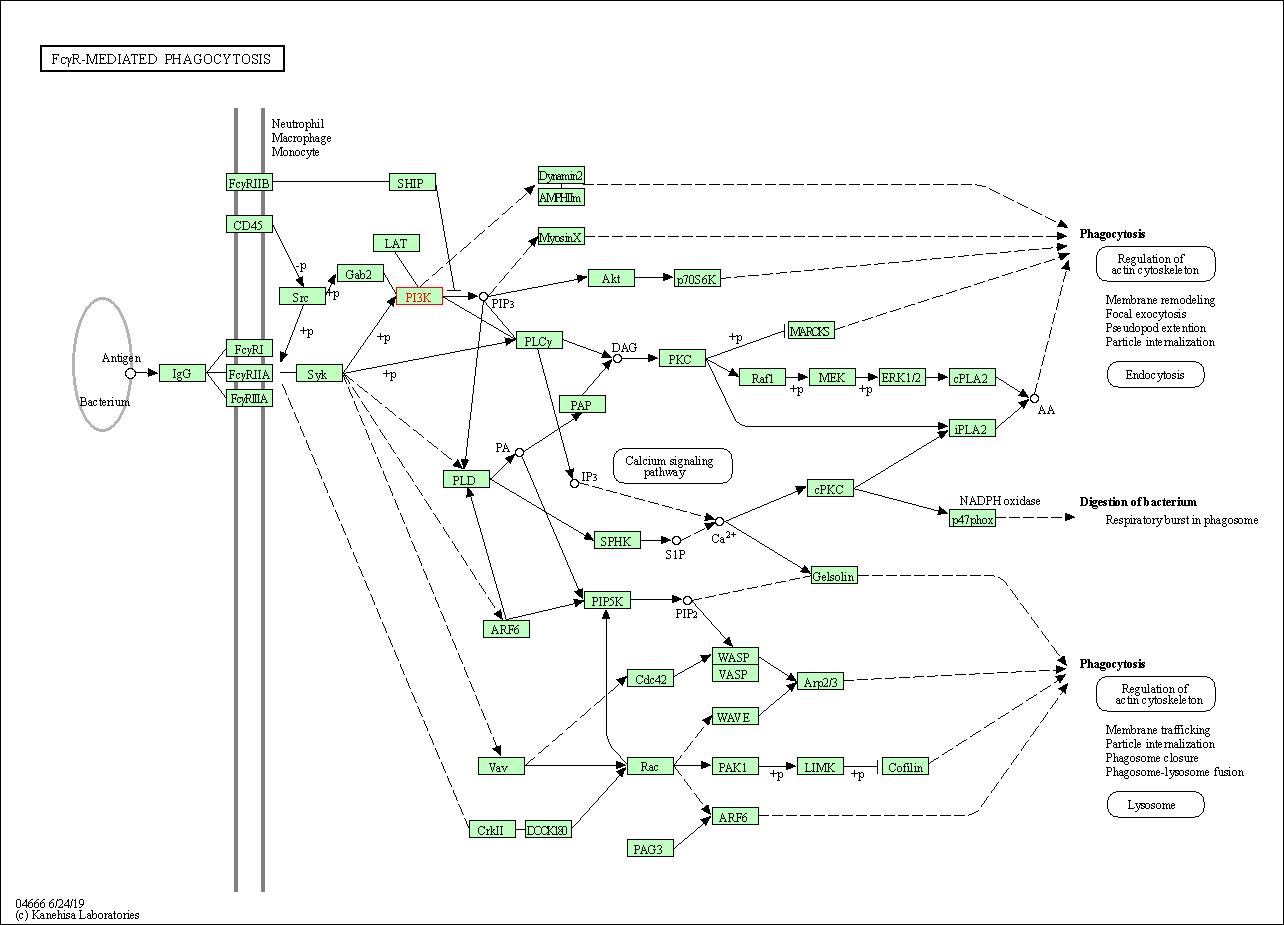
|
| Class: Organismal Systems => Immune system | Pathway Hierarchy | ||
| TNF signaling pathway | hsa04668 | Affiliated Target |
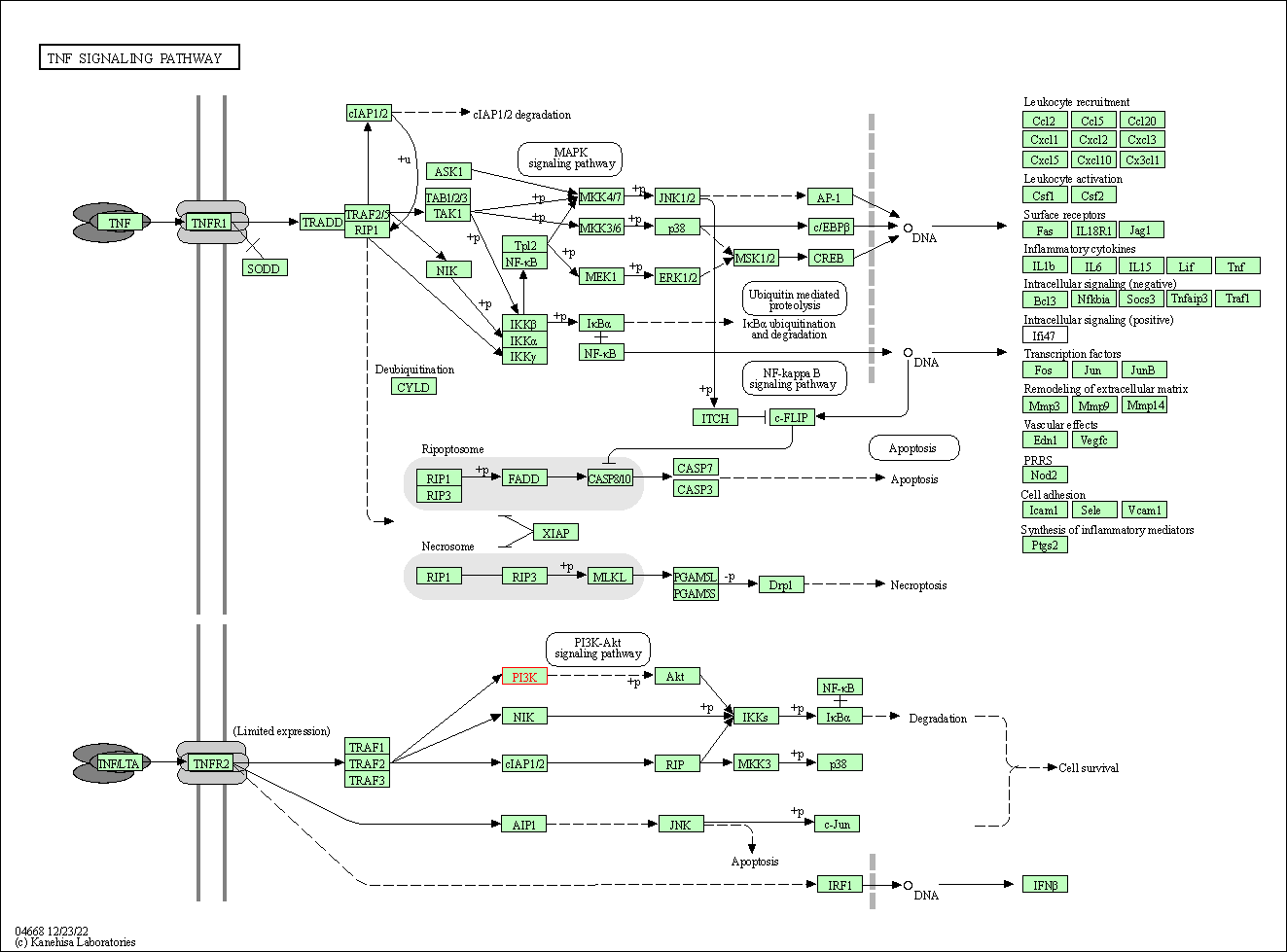
|
| Class: Environmental Information Processing => Signal transduction | Pathway Hierarchy | ||
| Leukocyte transendothelial migration | hsa04670 | Affiliated Target |

|
| Class: Organismal Systems => Immune system | Pathway Hierarchy | ||
| Neurotrophin signaling pathway | hsa04722 | Affiliated Target |
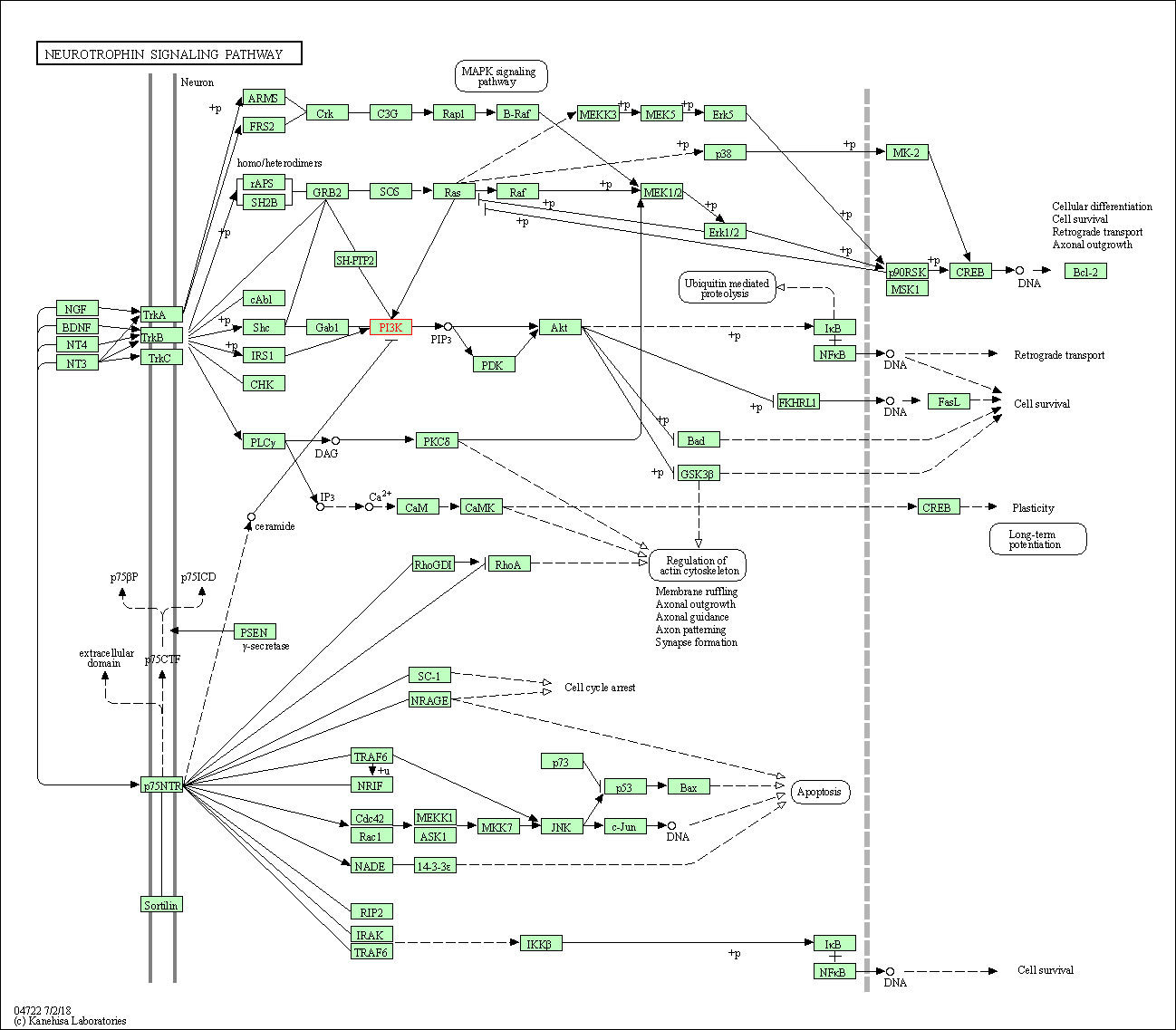
|
| Class: Organismal Systems => Nervous system | Pathway Hierarchy | ||
| Cholinergic synapse | hsa04725 | Affiliated Target |
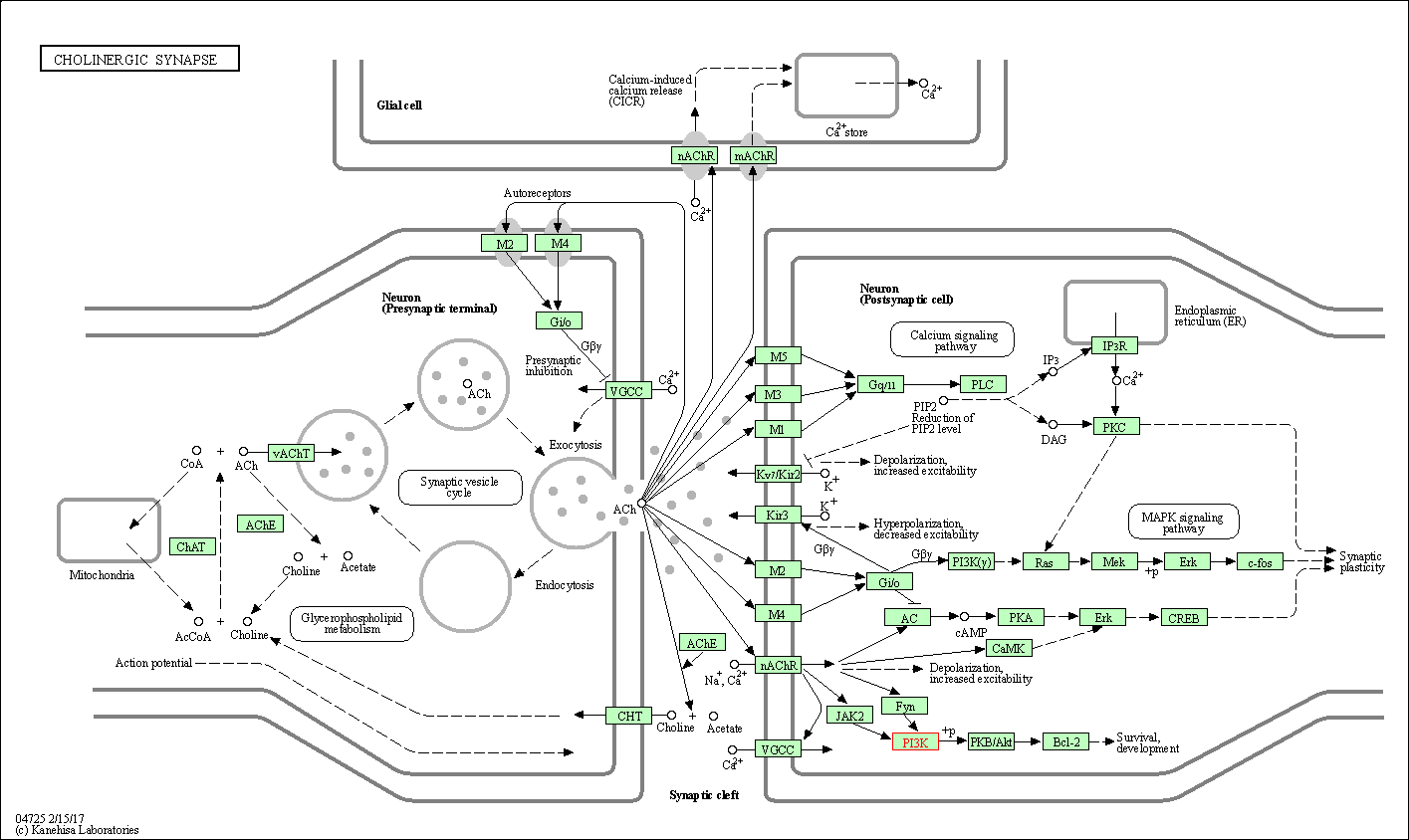
|
| Class: Organismal Systems => Nervous system | Pathway Hierarchy | ||
| Inflammatory mediator regulation of TRP channels | hsa04750 | Affiliated Target |
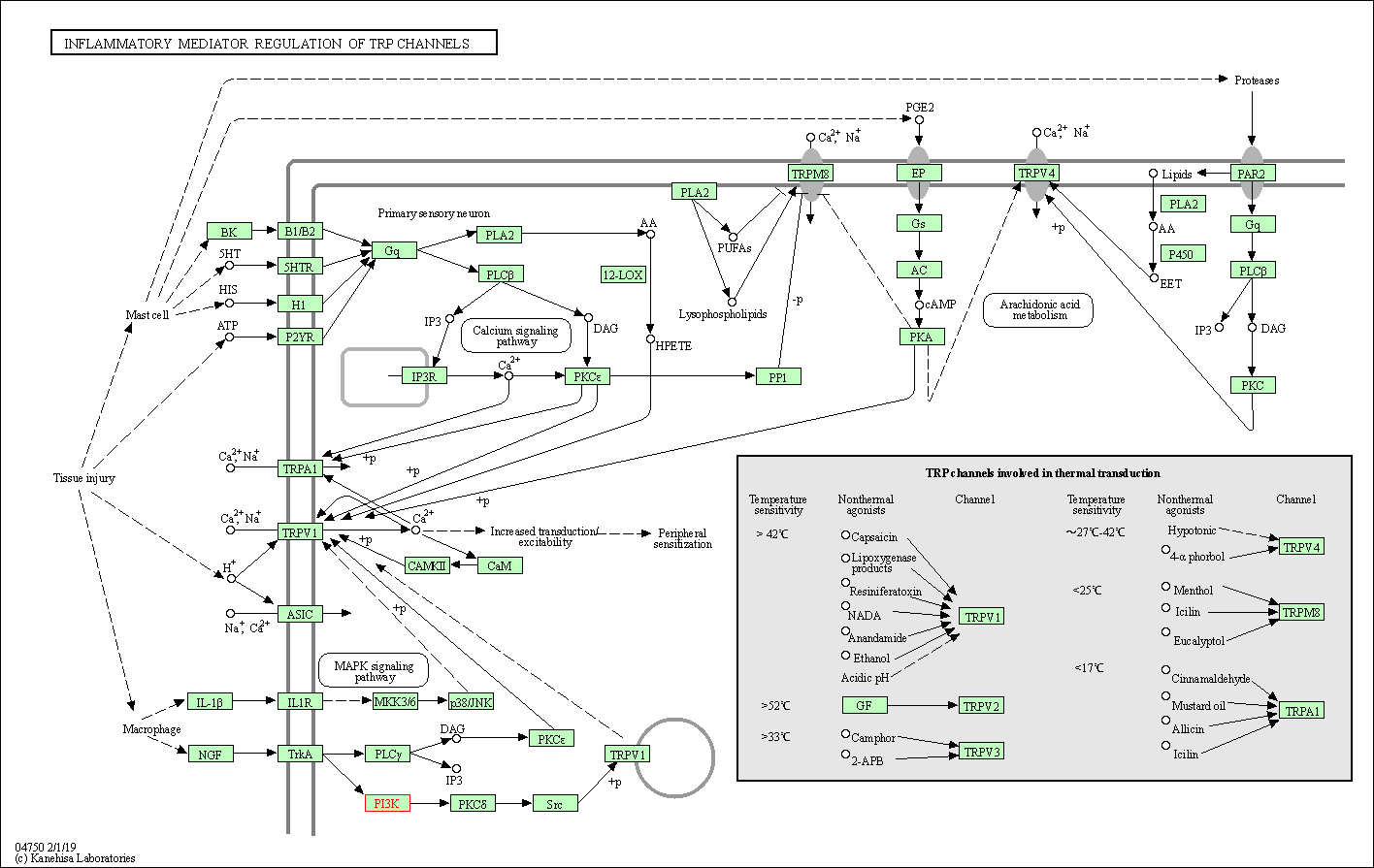
|
| Class: Organismal Systems => Sensory system | Pathway Hierarchy | ||
| Regulation of actin cytoskeleton | hsa04810 | Affiliated Target |
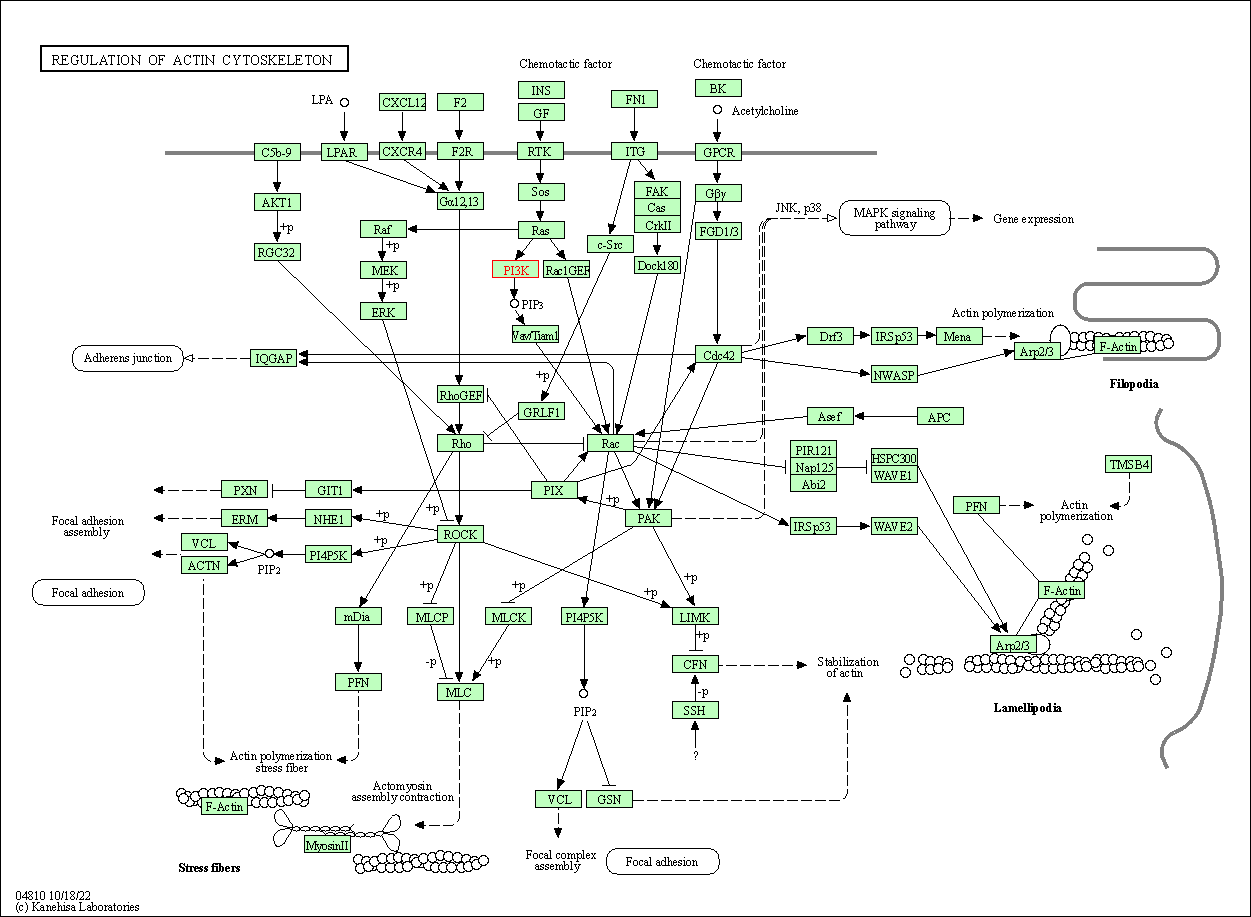
|
| Class: Cellular Processes => Cell motility | Pathway Hierarchy | ||
| Insulin signaling pathway | hsa04910 | Affiliated Target |
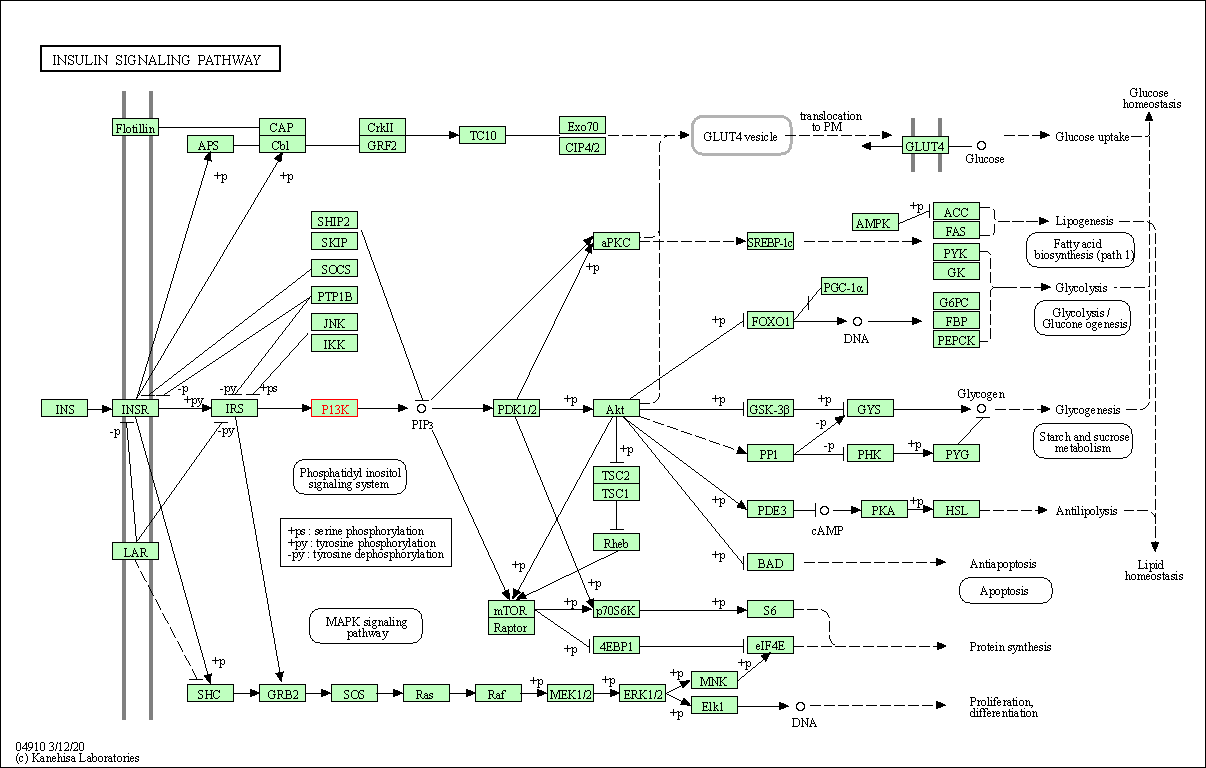
|
| Class: Organismal Systems => Endocrine system | Pathway Hierarchy | ||
| Progesterone-mediated oocyte maturation | hsa04914 | Affiliated Target |

|
| Class: Organismal Systems => Endocrine system | Pathway Hierarchy | ||
| Estrogen signaling pathway | hsa04915 | Affiliated Target |
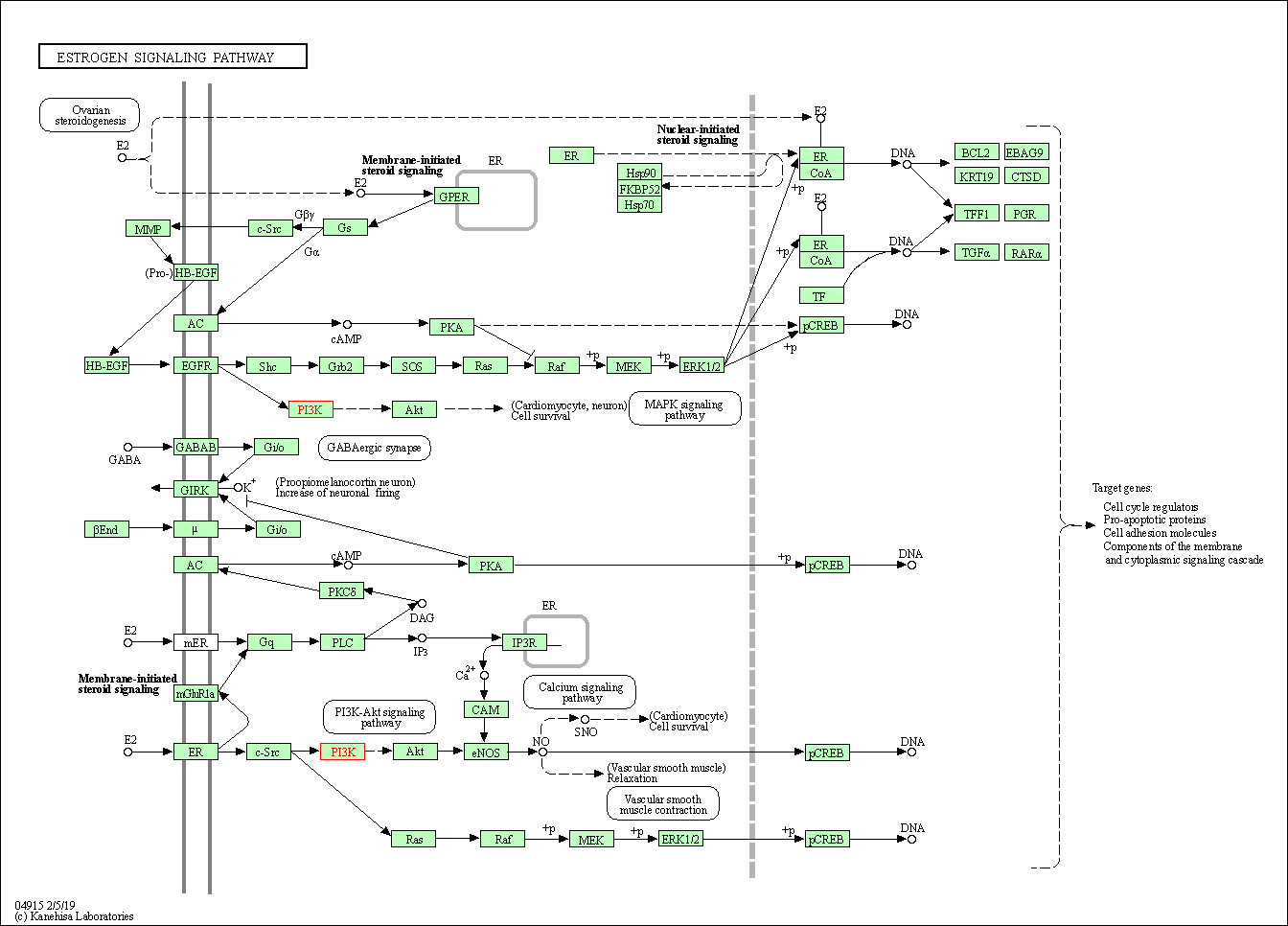
|
| Class: Organismal Systems => Endocrine system | Pathway Hierarchy | ||
| Prolactin signaling pathway | hsa04917 | Affiliated Target |

|
| Class: Organismal Systems => Endocrine system | Pathway Hierarchy | ||
| Thyroid hormone signaling pathway | hsa04919 | Affiliated Target |
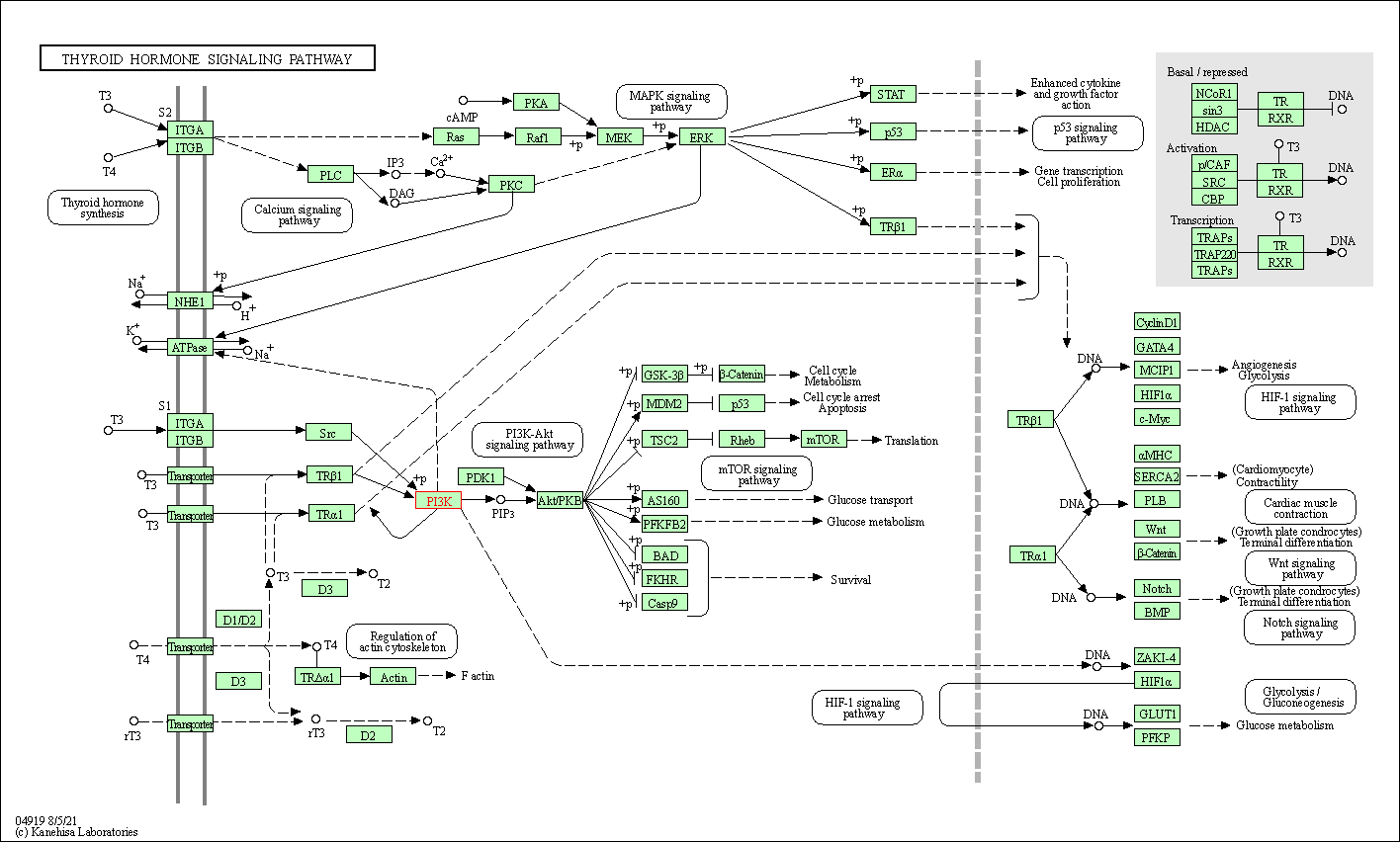
|
| Class: Organismal Systems => Endocrine system | Pathway Hierarchy | ||
| Regulation of lipolysis in adipocytes | hsa04923 | Affiliated Target |
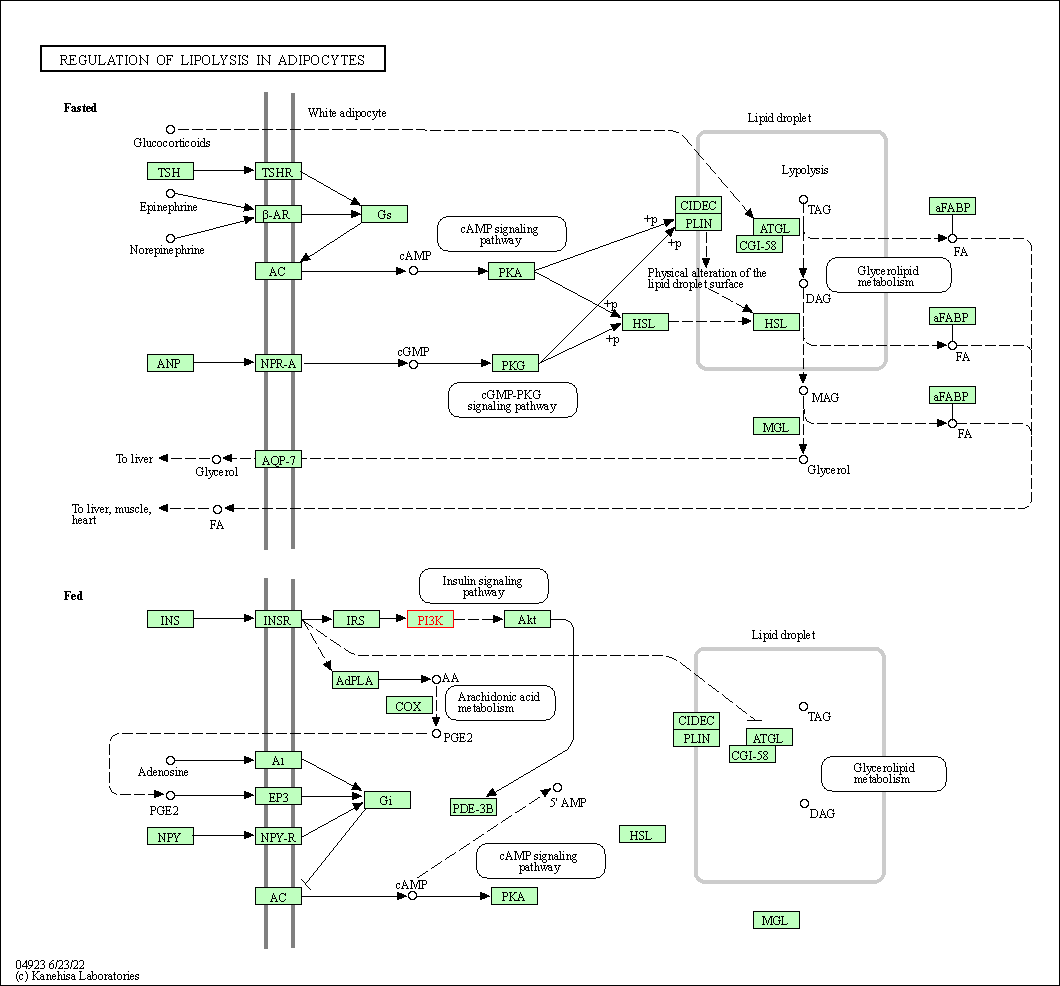
|
| Class: Organismal Systems => Endocrine system | Pathway Hierarchy | ||
| Relaxin signaling pathway | hsa04926 | Affiliated Target |
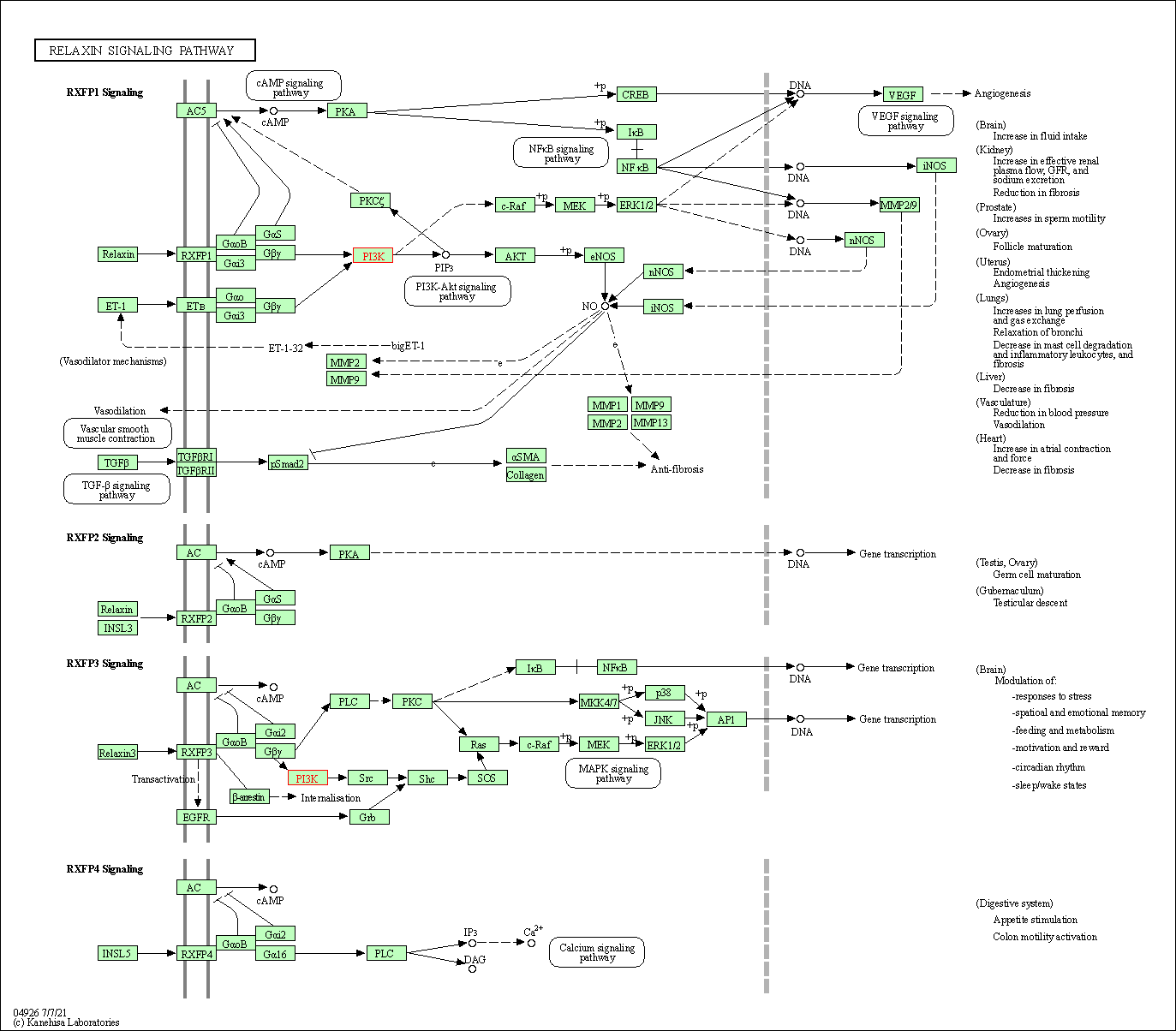
|
| Class: Organismal Systems => Endocrine system | Pathway Hierarchy | ||
| GnRH secretion | hsa04929 | Affiliated Target |
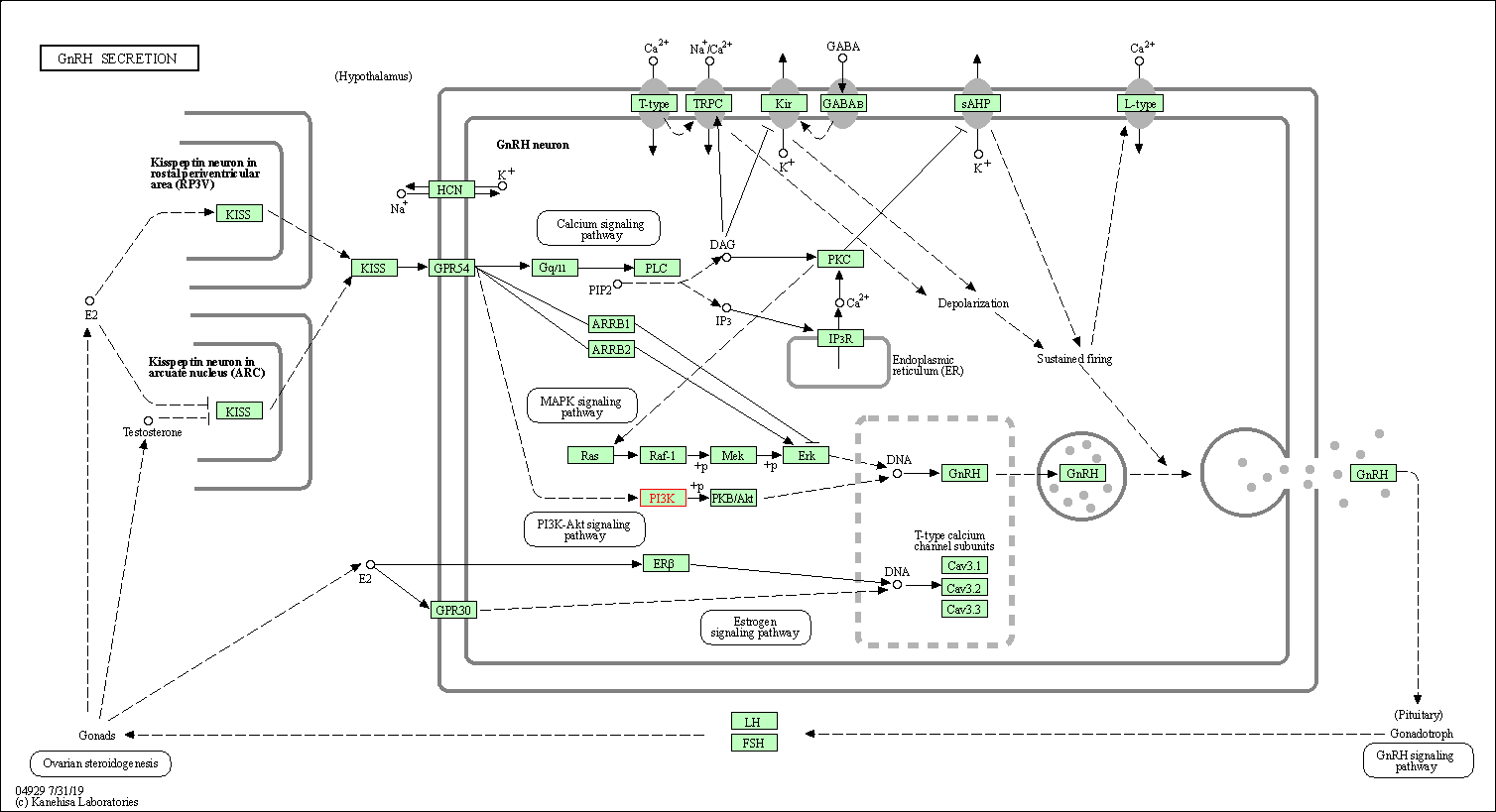
|
| Class: Organismal Systems => Endocrine system | Pathway Hierarchy | ||
| Growth hormone synthesis, secretion and action | hsa04935 | Affiliated Target |
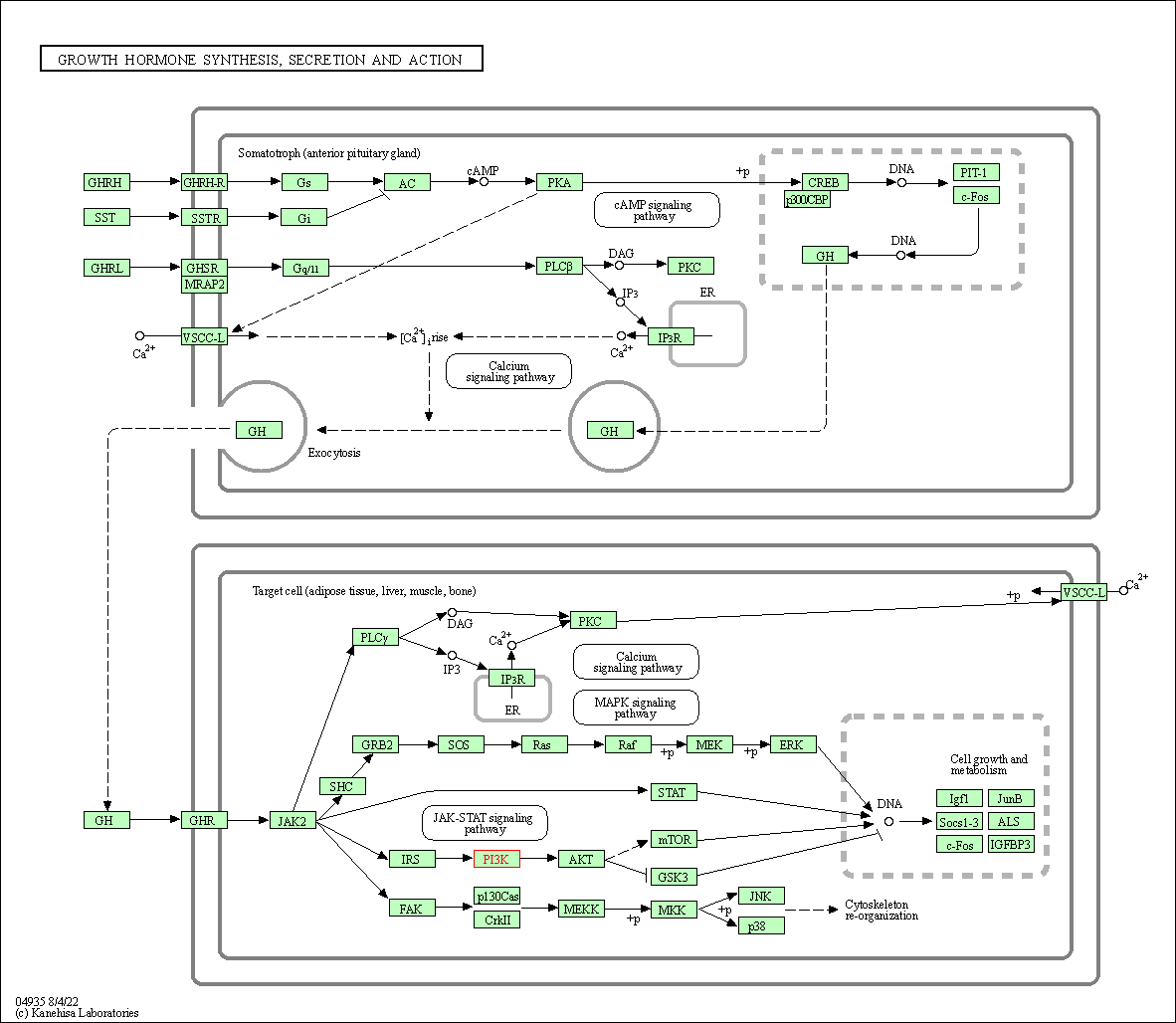
|
| Class: Organismal Systems => Endocrine system | Pathway Hierarchy | ||
| Aldosterone-regulated sodium reabsorption | hsa04960 | Affiliated Target |
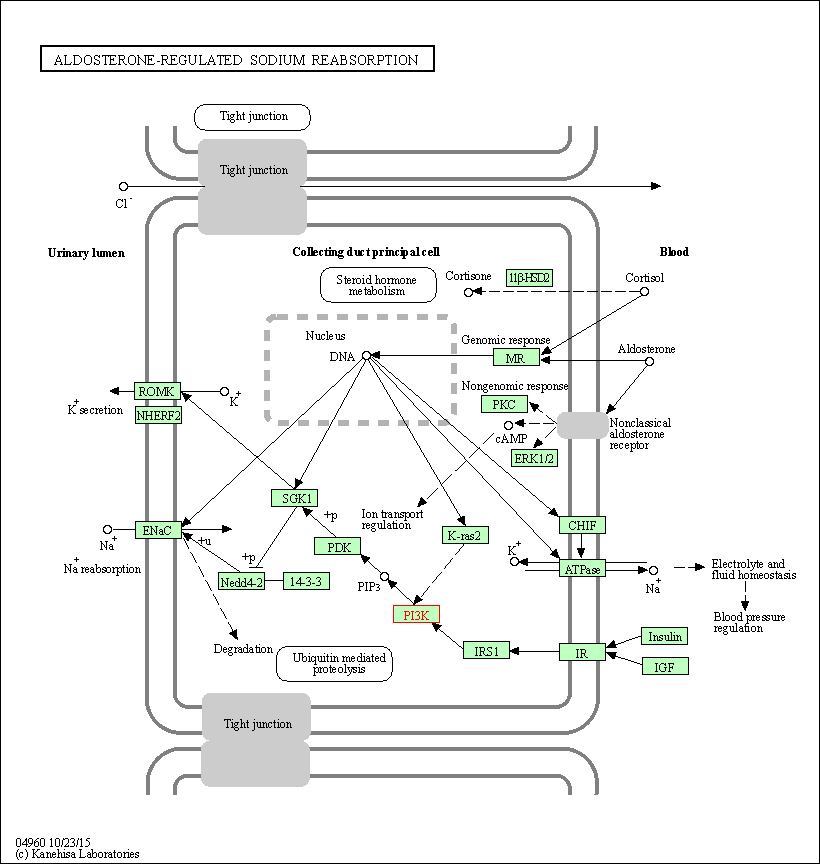
|
| Class: Organismal Systems => Excretory system | Pathway Hierarchy | ||
| Carbohydrate digestion and absorption | hsa04973 | Affiliated Target |
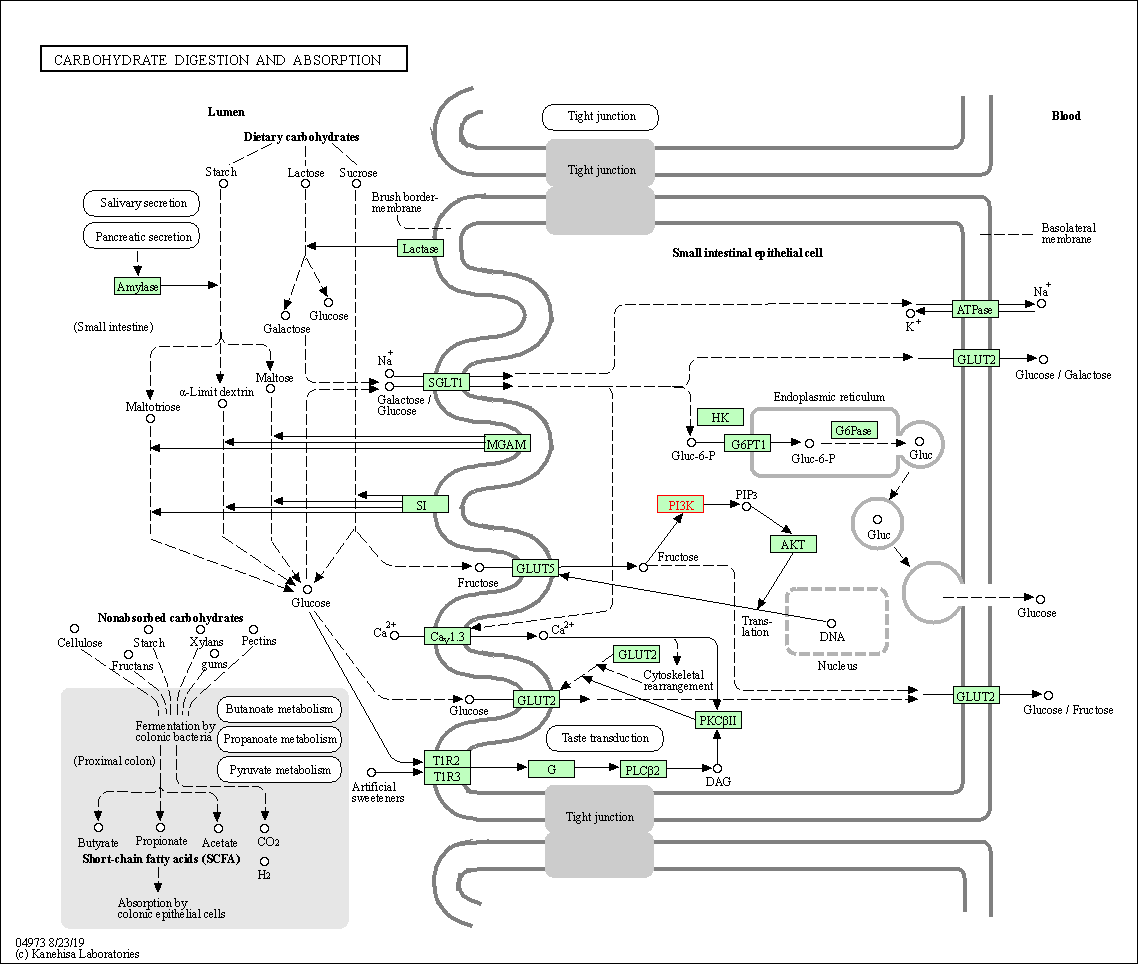
|
| Class: Organismal Systems => Digestive system | Pathway Hierarchy | ||
| Click to Show/Hide the Information of Affiliated Human Pathways | |||
| Degree | 56 | Degree centrality | 6.02E-03 | Betweenness centrality | 2.68E-03 |
|---|---|---|---|---|---|
| Closeness centrality | 2.66E-01 | Radiality | 1.46E+01 | Clustering coefficient | 2.04E-01 |
| Neighborhood connectivity | 5.20E+01 | Topological coefficient | 4.58E-02 | Eccentricity | 11 |
| Download | Click to Download the Full PPI Network of This Target | ||||
| Chemical Structure based Activity Landscape of Target | Top |
|---|---|
| Drug Property Profile of Target | Top | |
|---|---|---|
| (1) Molecular Weight (mw) based Drug Clustering | (2) Octanol/Water Partition Coefficient (xlogp) based Drug Clustering | |
|
|
||
| (3) Hydrogen Bond Donor Count (hbonddonor) based Drug Clustering | (4) Hydrogen Bond Acceptor Count (hbondacc) based Drug Clustering | |
|
|
||
| (5) Rotatable Bond Count (rotbonds) based Drug Clustering | (6) Topological Polar Surface Area (polararea) based Drug Clustering | |
|
|
||
| "RO5" indicates the cutoff set by lipinski's rule of five; "D123AB" colored in GREEN denotes the no violation of any cutoff in lipinski's rule of five; "D123AB" colored in PURPLE refers to the violation of only one cutoff in lipinski's rule of five; "D123AB" colored in BLACK represents the violation of more than one cutoffs in lipinski's rule of five | ||
| Co-Targets | Top | |||||
|---|---|---|---|---|---|---|
| Co-Targets | ||||||
| Target Poor or Non Binders | Top | |||||
|---|---|---|---|---|---|---|
| Target Poor or Non Binders | ||||||
| Target Regulators | Top | |||||
|---|---|---|---|---|---|---|
| Target-regulating microRNAs | ||||||
| Target-interacting Proteins | ||||||
| Target Profiles in Patients | Top | |||||
|---|---|---|---|---|---|---|
| Target Expression Profile (TEP) | ||||||
| Drug Resistance Mutation (DRM) | ||||||
| References | Top | |||||
|---|---|---|---|---|---|---|
| REF 1 | 2017 FDA drug approvals.Nat Rev Drug Discov. 2018 Feb;17(2):81-85. | |||||
| REF 2 | Drugs@FDA. U.S. Food and Drug Administration. U.S. Department of Health Human Services. 2019 | |||||
| REF 3 | Clinical pipeline report, company report or official report of the Pharmaceutical Research and Manufacturers of America (PhRMA) | |||||
| REF 4 | URL: http://www.guidetopharmacology.org Nucleic Acids Res. 2015 Oct 12. pii: gkv1037. The IUPHAR/BPS Guide to PHARMACOLOGY in 2016: towards curated quantitative interactions between 1300 protein targets and 6000 ligands. (Ligand id: 7878). | |||||
| REF 5 | ClinicalTrials.gov (NCT01610284) Phase III Study of BKM120/Placebo With Fulvestrant in Postmenopausal Patients With Hormone Receptor Positive HER2-negative Locally Advanced or Metastatic Breast Cancer Refractory to Aromatase Inhibitor. U.S. National Institutes of Health. | |||||
| REF 6 | ClinicalTrials.gov (NCT02549989) Study of LY3023414 for the Treatment of Recurrent. | |||||
| REF 7 | ClinicalTrials.gov (NCT02393209) Docetaxel With or Without MLN1117 in Participants With Locally Advanced or Metastatic Non-small Cell Lung Cancer. U.S. National Institutes of Health. | |||||
| REF 8 | ClinicalTrials.gov (NCT04495621) MEN1611 With Cetuximab in Metastatic Colorectal Cancer (C-PRECISE-01) (C-PRECISE-01). U.S. National Institutes of Health. | |||||
| REF 9 | ClinicalTrials.gov (NCT01407380) Study of PWT33597 Mesylate in Subjects With Advanced Malignancies. U.S. National Institutes of Health. | |||||
| REF 10 | ClinicalTrials.gov (NCT04856371) Study of CYH33 in Combination With Endocrine Therapy With or Without Palbociclib in Patients With HR+, HER2- Advanced Breast Cancer. U.S. National Institutes of Health. | |||||
| REF 11 | ClinicalTrials.gov (NCT05307705) A Study of LOXO-783 Administered as Monotherapy and in Combination With Anticancer Therapies for Patients With Advanced Breast Cancer and Other Solid Tumors With a PIK3CA H1047R Mutation. U.S.National Institutes of Health. | |||||
| REF 12 | In vitro anticancer activity of PI3K alpha selective inhibitor BYL719 in head and neck cancer. Anticancer Res. 2015 Jan;35(1):175-82. | |||||
| REF 13 | Targeting the phosphoinositide 3-kinase pathway in cancer. Nat Rev Drug Discov. 2009 Aug;8(8):627-44. | |||||
| REF 14 | Company report (Lilly) | |||||
| REF 15 | The selective class I PI3K inhibitor CH5132799 targets human cancers harboring oncogenic PIK3CA mutations. Clin Cancer Res. 2011 May 15;17(10):3272-81. | |||||
| REF 16 | Discovery of NVP-BYL719 a potent and selective phosphatidylinositol-3 kinase alpha inhibitor selected for clinical evaluation. Bioorg Med Chem Lett. 2013 Jul 1;23(13):3741-8. | |||||
| REF 17 | Identification of allosteric binding sites for PI3KAlpha oncogenic mutant specific inhibitor design. Bioorg Med Chem. 2017 Feb 15;25(4):1481-1486. | |||||
If You Find Any Error in Data or Bug in Web Service, Please Kindly Report It to Dr. Zhou and Dr. Zhang.

